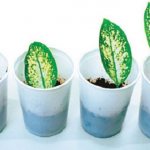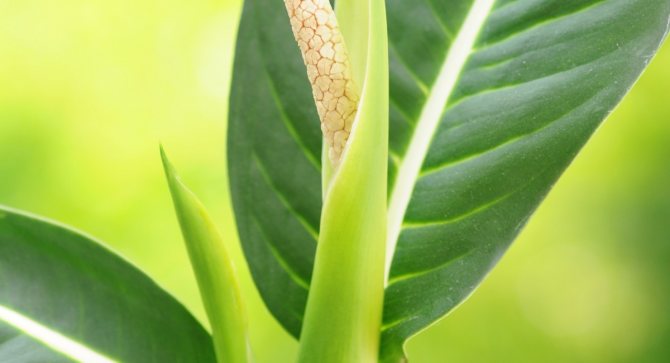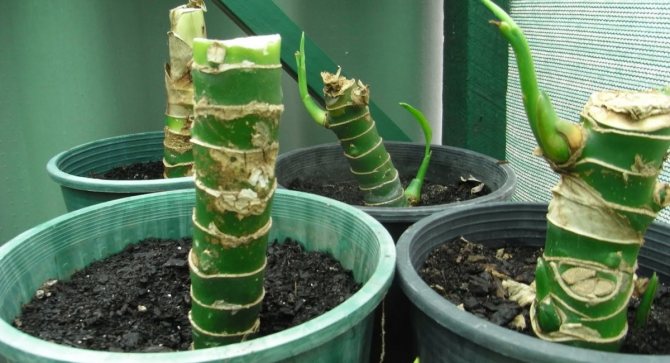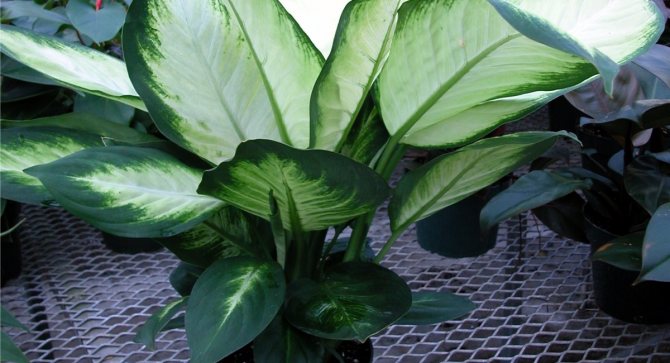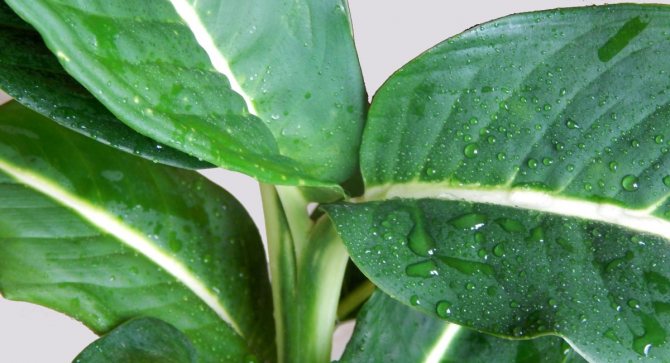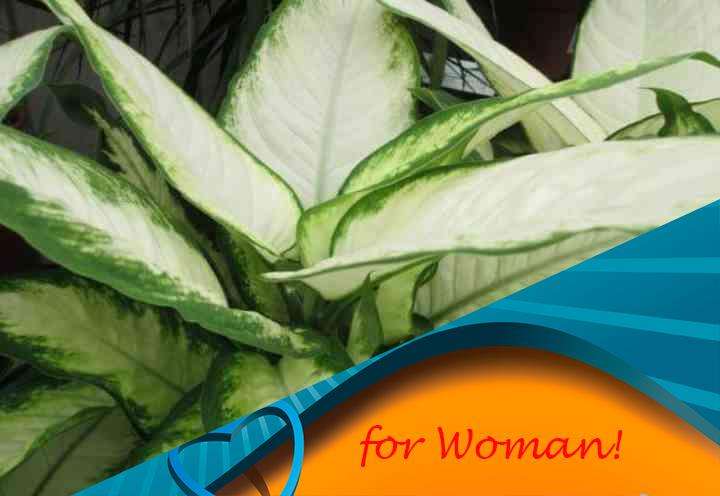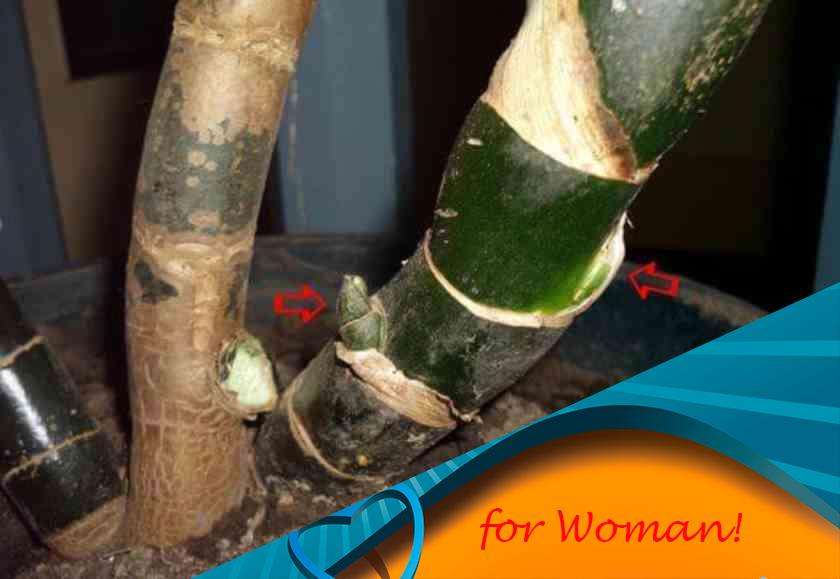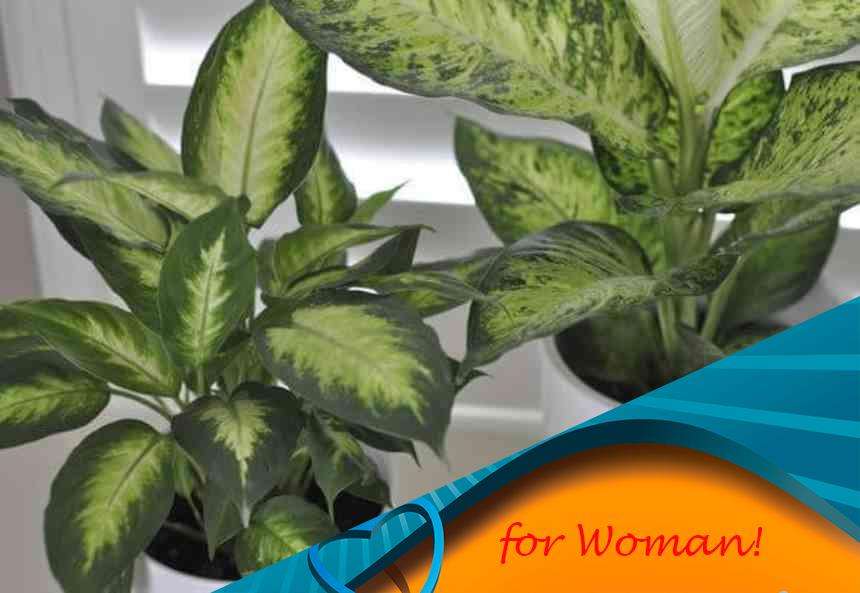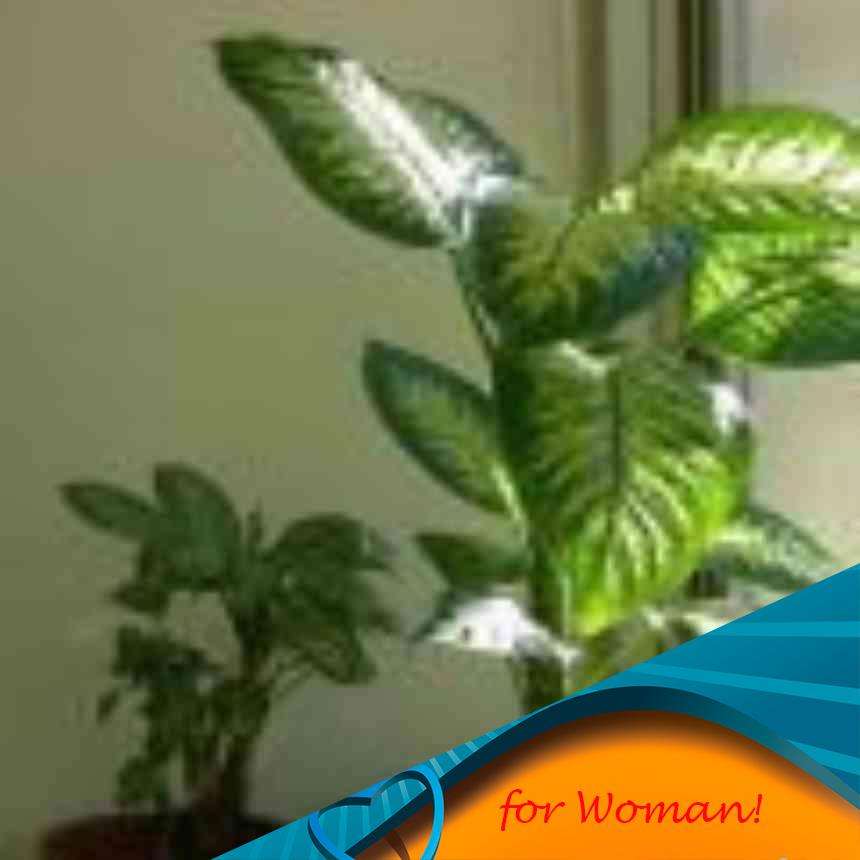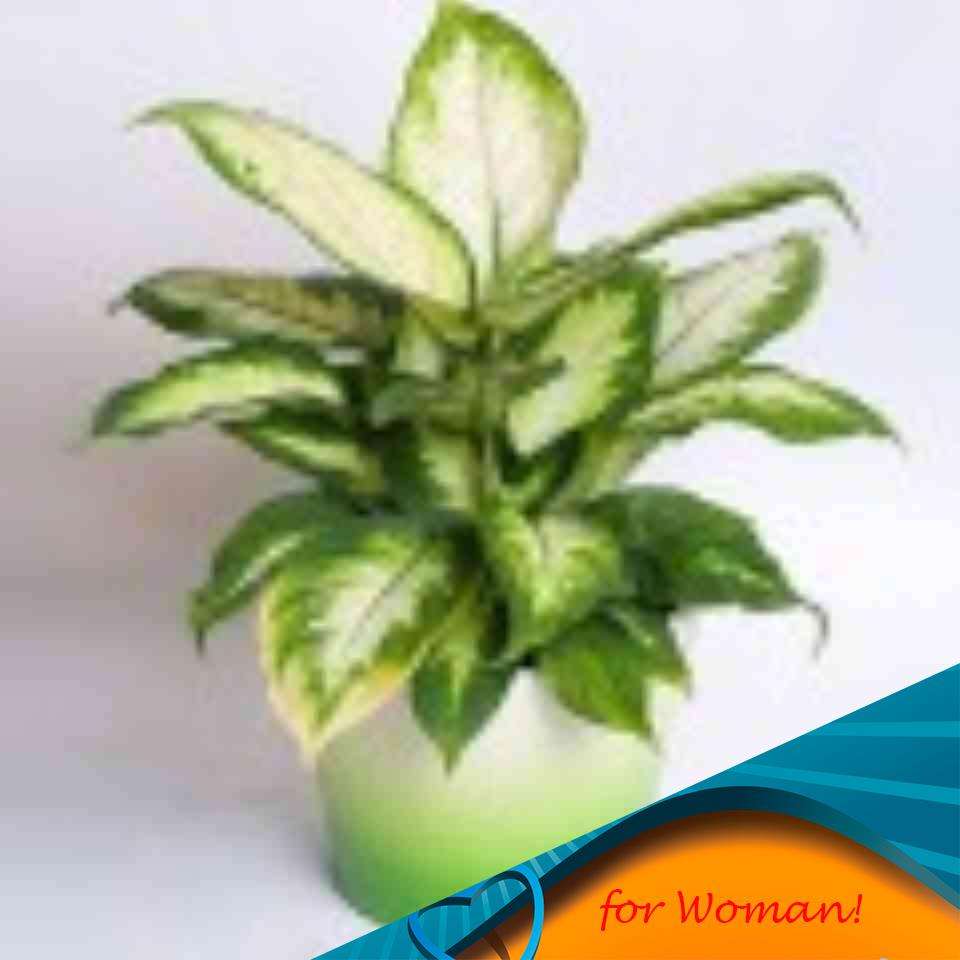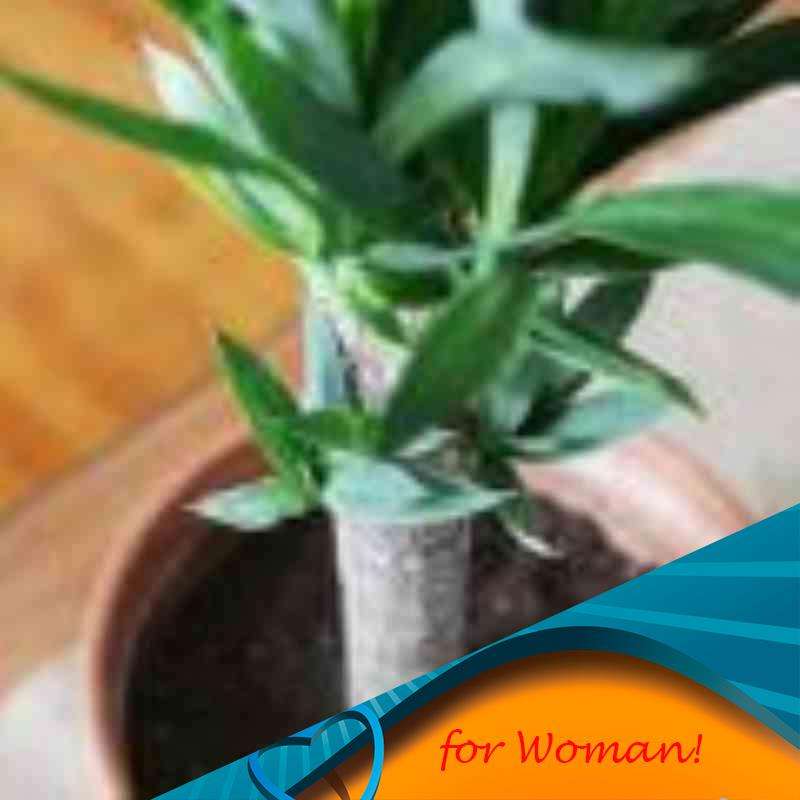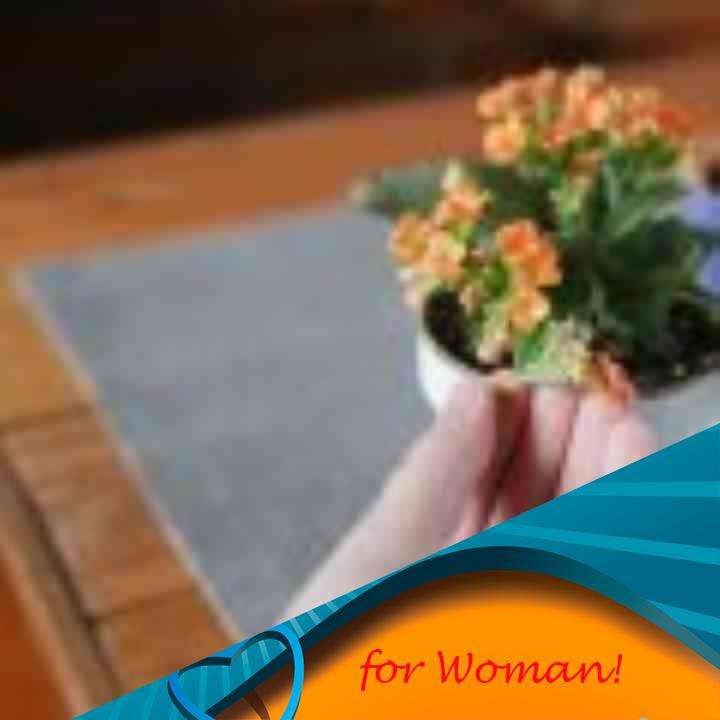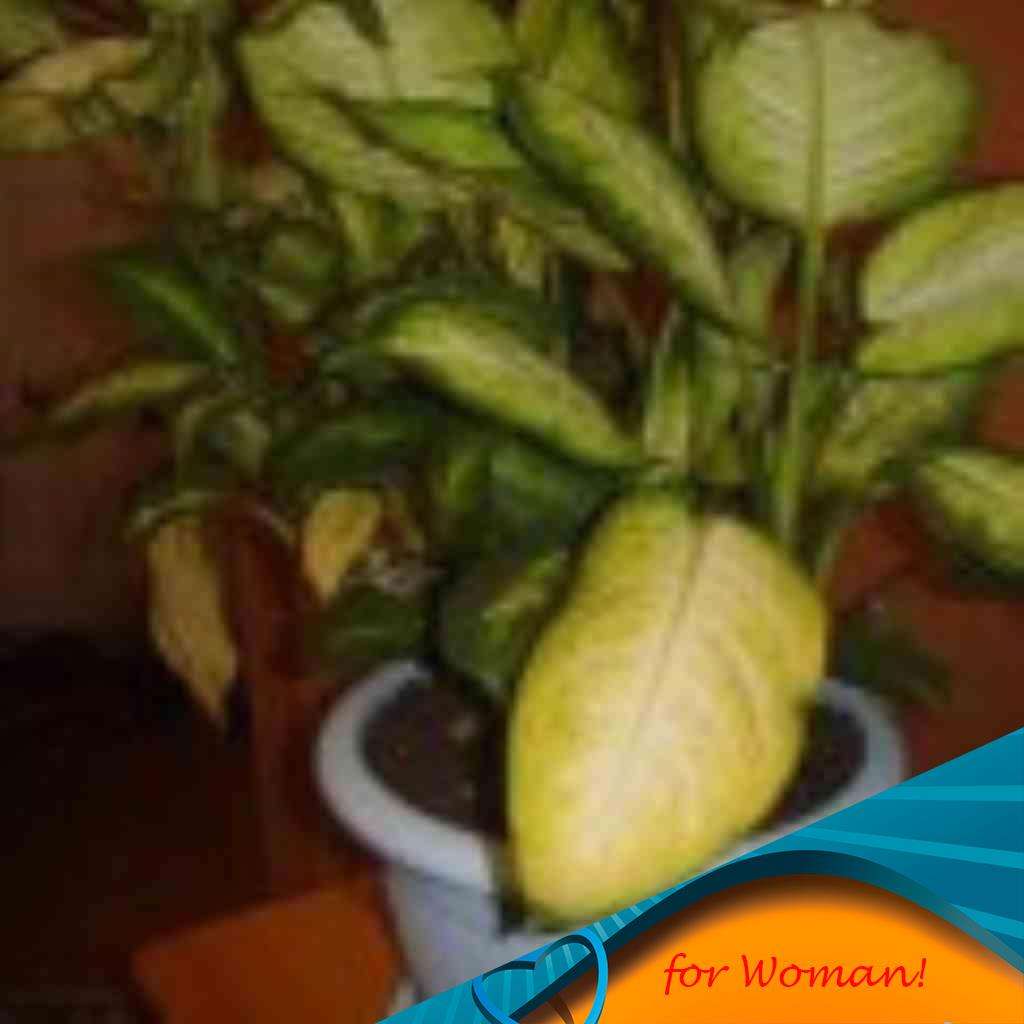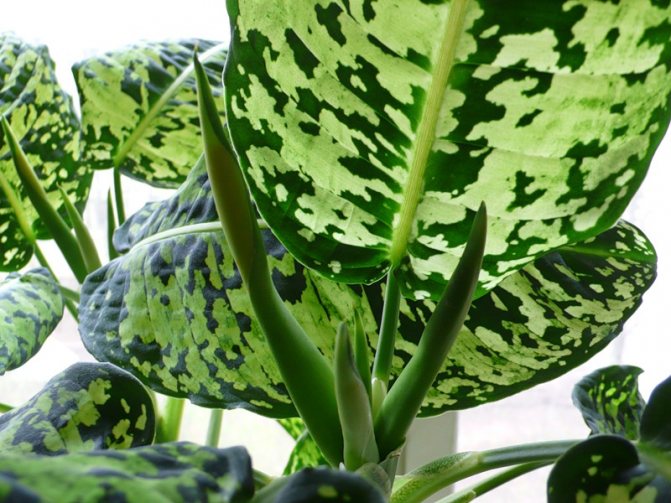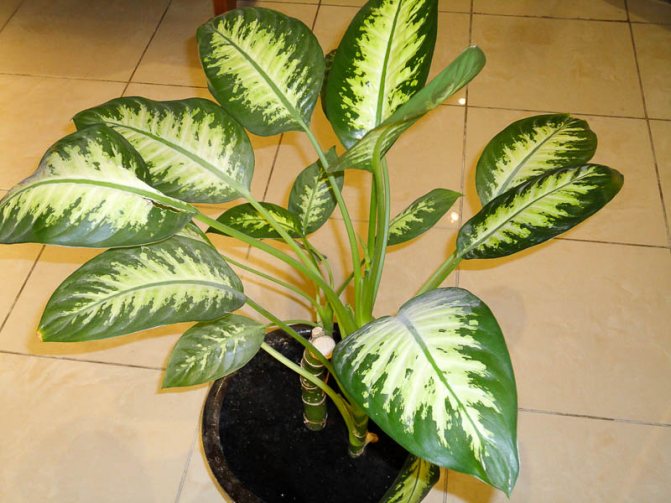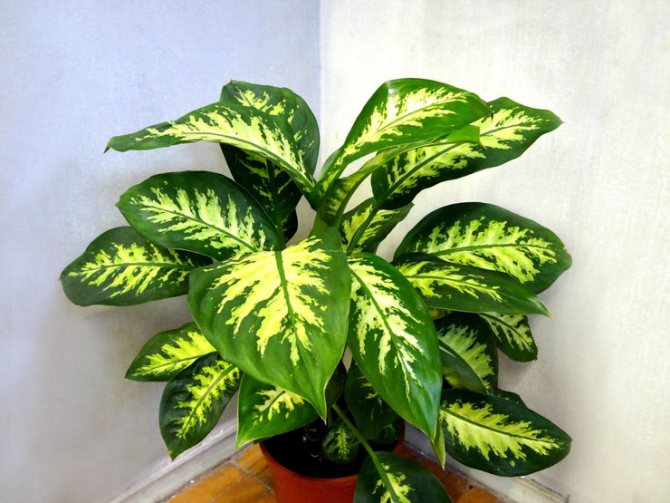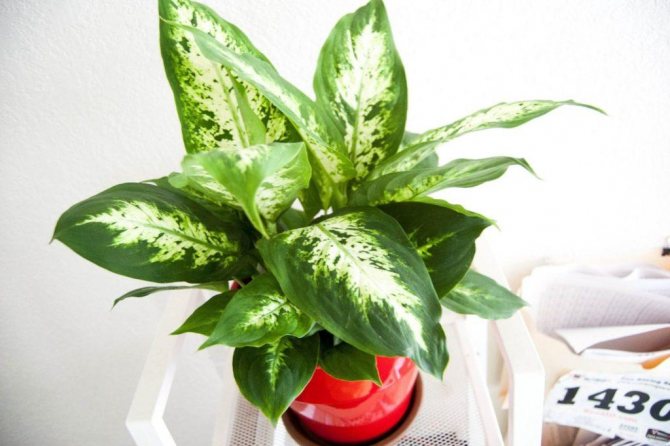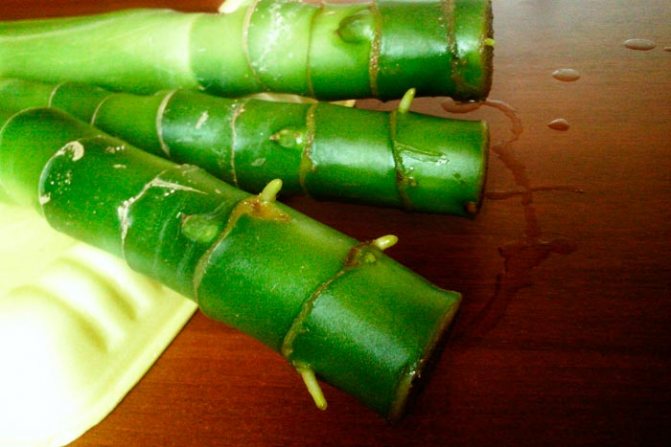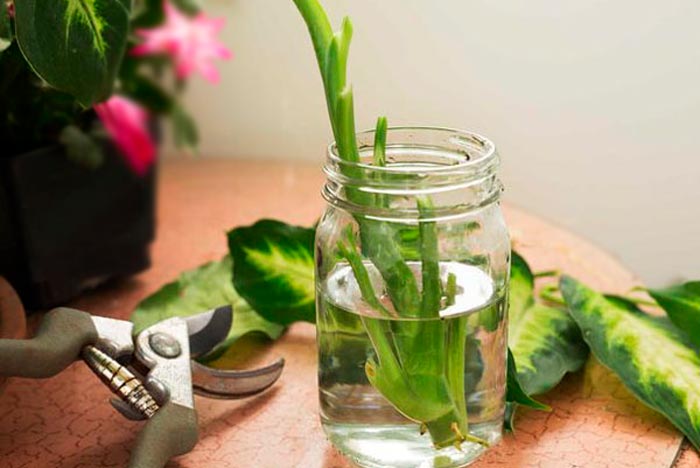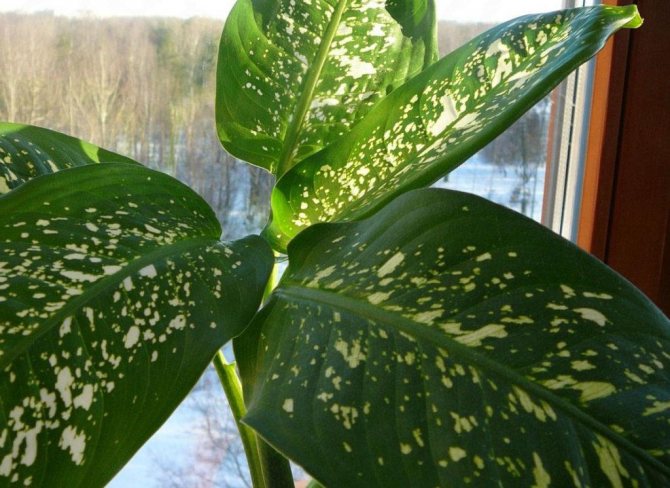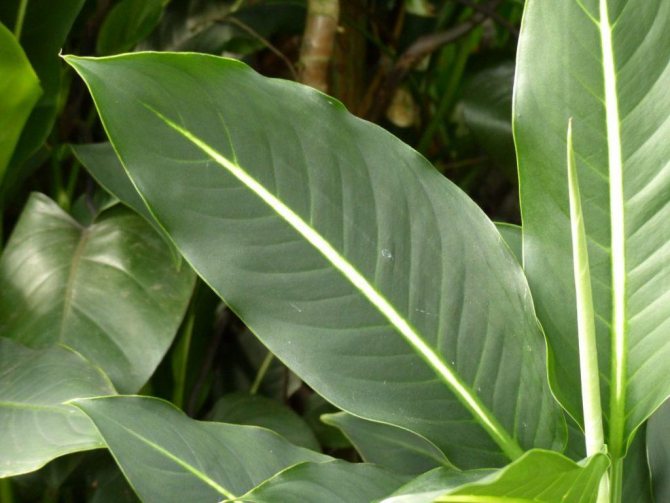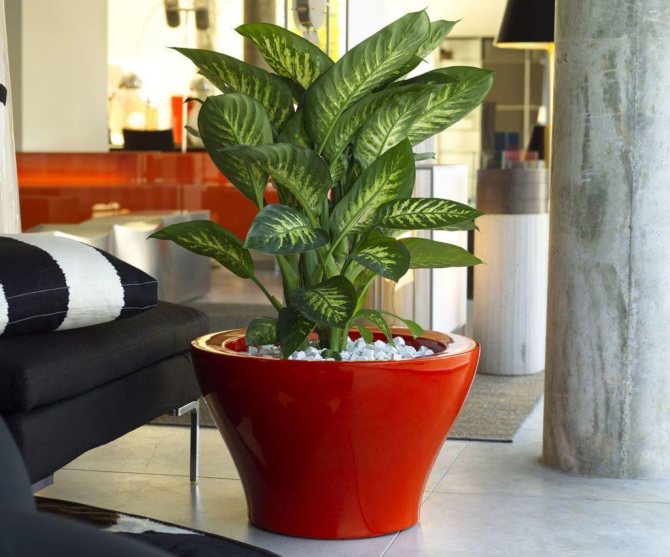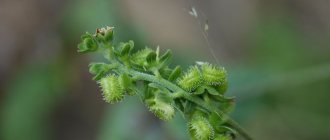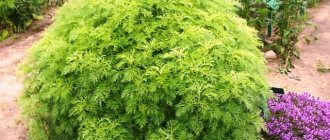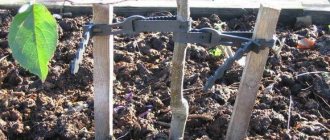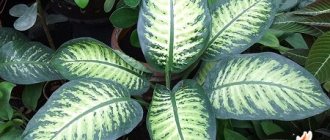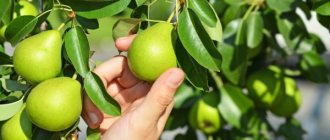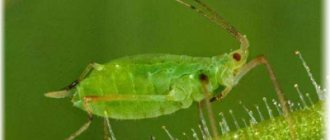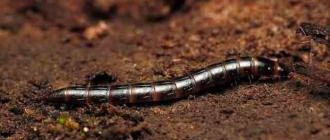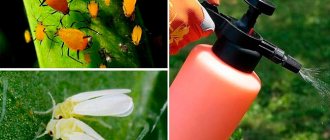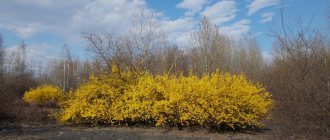Houseplants have long been the most exquisite home decoration, as they give a feeling of comfort and peace. Dieffenbachia is one of the most beautiful domestic flowers. Reproduction of dieffenbachia at home is a simple process, but it requires some skill and knowledge. In addition, the indoor flower is quite unpretentious and easy to care for, but very effective.
In this article you can find up-to-date information on how dieffenbachia reproduces at home, a description and recommendations for each method.
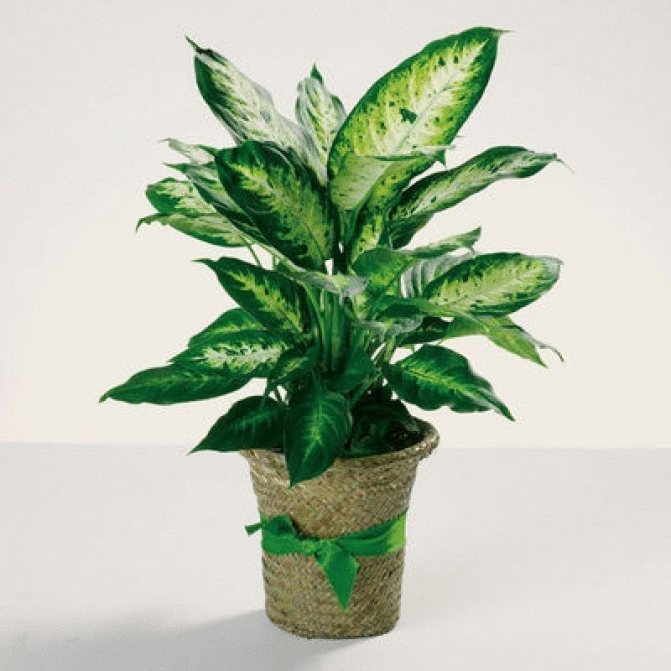
Pruning time
Dieffenbachia is a flower that stretches upward, but does not bush. To give it the appropriate shape, you need to prune the plant.
The first time you can cut dieffenbachia when it reaches the age of 2-3 years. It is carried out when it is found:
- the stem is bare from below;
- the top shaggy from the excess of leaves;
- falling and yellowing of leaves.
It is advisable to carry out pruning in winter, during a dormant period, although if urgently needed, you can do this at any other time.
In the future, radical pruning is performed every 2-4 years. This allows you to grow several plants from the trimmed part.
Choosing a new pot and soil
Before preparing dieffenbachia for transplantation, you need to tackle the choice of the optimal soil and capacity.
You need to plant the plant in a pot that is 1–3 cm larger than the previous one. The new container can be taken from the same material as the old pot. Although, if desired, plastic can be replaced with clay, and vice versa.
It is imperative to prepare fresh soil. It is not recommended to buy soil for this flower in a flower shop. The fact is that purchased land is moisture-consuming. When grown in it, the plant will rot its roots.
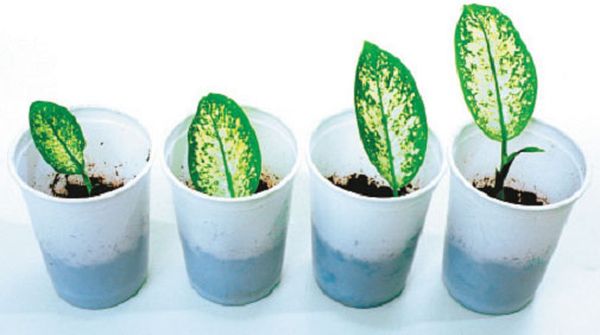

You can cook the earth yourself. But for this you need to know the optimal composition of the soil. Dieffenbachia grows well on a mixture of peat, sand and turf. These components are taken in the same proportion. You can add 4 pieces of leafy soil to the soil. Also, the composition of the soil for this flower can be as follows: humus (2 parts), peat (2 parts), leafy earth (2 parts) and sand (1 part). It is recommended to sterilize it before using the soil mixture. It is worth noting that if dieffenbachia is higher than 1 m, then the soil for it should be prepared more difficult. It is recommended here to increase the part of the leafy land. Also, some growers add crushed sphagnum moss, charcoal, garden soil or soil from under coniferous trees to such a soil mixture. Drainage (brick chips, charcoal) is placed in the selected pot, at the bottom of which there must be holes. Only after that, self-prepared soil is poured into the container.
Pruning Dieffenbachia
An adult plant that is well-rooted is subject to pruning. Before the procedure, you need to prepare:
- a sharp knife with fine teeth and alcohol for processing it;
- cotton pads;
- Activated carbon;
- glass container.
The sequence of actions is as follows:
- a horizontal cut is made with a knife so that small buds in the amount of 2-5 pieces are present on the remaining part;
- alcohol is applied to a cotton pad and the cut site is treated to avoid the appearance of mold and bacteria;
- the stump is covered with a container, it is periodically removed for ventilation.
Since the culture is poisonous, all manipulations are performed strictly with gloves! Wash your hands thoroughly after work!
If desired, a new flower can be grown from the cut part. To do this, it is dried during the day in the open air, then placed in water in which crushed activated carbon is dissolved.
Already after 2 weeks, you can find out how the stalk has started up the first roots. After they appear, you need to root the plant by planting it in a container with soil. This is how pruning flows into the breeding process.
Attention: Dieffenbachia plant is poisonous!
Since dieffenbachia secretes poisonous juice, gloves should always be used when working with a flower, which will protect against harmful substances that affect the skin. If, nevertheless, there was a situation in which the juice got on the skin and caused irritation, you do not need to try to wipe it off - sharp crystals of calcium oxalate will stick even more into the top layer of the skin. It is best to put the affected part of the body under a stream of water so that it rinses off the juice from the surface. After working with dieffenbachia, you must thoroughly wash your hands with soap, so that microscopic plant particles do not remain on them, which can irritate the skin or mucous membranes of a person.
Necessity and timing of transplant
There are several reasons for transplanting a flower:
- the need to improve its appearance;
- the root system is cramped in the pot.
The transplant should be carried out on time, otherwise the flower will begin to ache and shed foliage, and will slow down its growth. Small new foliage is also a signal, as well as the rapid drying of the substrate after watering.
It is advisable to replant the culture in the spring, before the stage of active vegetation. For young plants, the pot is changed annually.
The origin of dieffenbachia: a biological portrait
Dieffenbachia belongs to the Aroid family. This is an ornamental evergreen plant, distinguished by large leaves with a variegated color and a lush crown of various shades. The homeland of the flower culture is South America, therefore, like any tropical flora, it prefers high humidity. In favorable conditions for growth, dieffenbachia reaches a height of 2 meters.
The shrub got its name from the German botanist Dieffenbach, who put a lot of effort into the domestication of wild culture. The plant rarely blooms, its buds resemble an ear, wrapped in a dull white bracts. After the flowering process is completed, a bunch of red or orange berries develops in its place.
Under natural conditions, the life of a tropical plant lasts up to 10 years. In an indoor flower, this period is reduced by 2-3 times. At the same time, home dieffenbachia often does not overcome the height threshold of 1 meter. For 4 years, you can grow a lush shrub in an apartment. As it ages, the plant will lose its decorative appearance. Large leaves will fall off, the plant will become lethargic.
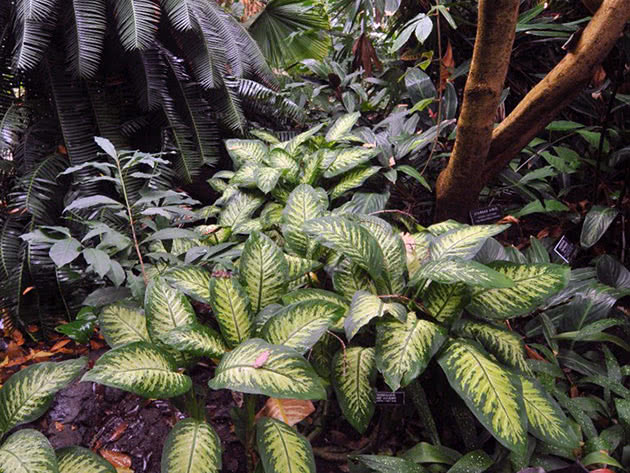

Transfer
Before transplanting a dieffenbachia with a long trunk, you need to prepare a new pot, which should be 2-3 cm larger than the previous one. You will also need new nutritious, loose soil and material for the drainage layer, for example, expanded clay.
The transplant is carried out by the transshipment method. First, you need to carefully remove the plant from the old pot and carefully examine the roots. If necessary, you need to remove:
- affected parts;
- damaged, dry appendages.
Having straightened the roots, remove the adhering earth and treat the sections with a fungicide, crushed activated carbon is also suitable. This will protect the plant from the appearance of infection or viruses.
A drainage layer is poured into a new container, on top - a layer of earth. You can use both a special composition for fruit and deciduous crops, and independently prepared soil. It includes river sand, deciduous soil, moss and peat.The finished mixture should be moderately acidic.
A plant is installed on top of the ground, the free space is filled with the remaining substrate, compacted, watered.
Dieffenbachia - signs
People who are accustomed to looking for an explanation of their problems and troubles by the standing of the planets, a horoscope and some mystical laws, often ask what, in an esoteric sense, the appearance of dieffenbachia in the house threatens. With this question, it is better to turn to a fortune teller, psychic or astrologer, but there are a couple of signs about dieffenbachia that many know about. So, for those who do not know these signs: they say that Dieffenbachia, along with hibiscus, is the strongest "muzhegon". That in families growing this flower in their home, children are not born, because men lose the ability to conceive. And generally they lose the ability to be men.
Using many examples, I could refute these tales, but it is unlikely that people who believe in omens will listen to me. They also say that you can't keep dieffenbachia in the bedroom, because it absorbs oxygen. To this I can answer that such nonsense is contrary to the law of photosynthesis and common sense. In addition, if you are looking for a bad sign or bad omen in everything, you are attracting problems, misfortunes and other negativity to yourself. Dieffenbachia is just a beautiful plant, and this is how it should be treated. Pay attention to cats: they gladly eat dieffenbachia leaves, since for them it is just an anthelmintic.
Care
After transplanting and pruning, the flower needs time to recover. At this time, he is provided with high-quality care, which allows the plant to quickly take root and stretch, overgrowing with new foliage.
Lighting and temperature
The culture needs good lighting without direct sunlight. The best option for placing a pot in the house is a place where light partial shade reigns. It can be southwest or southeast.
Indoor air temperature is also an important parameter. It should be around 18-25 degrees Celsius. In such conditions, the flower will quickly regain its strength. In the summer, you can take it out on the balcony or in the garden.
Watering
Dieffenbachia needs regular watering, for this they use warm, settled water. For the period of growth of new branches for several days, you need to abandon this procedure. During the rest period, the frequency of watering is reduced.
It is important to monitor the condition of the soil, avoiding waterlogging. This has a detrimental effect on the state of the flower, it may die.
Air humidity
This parameter is very important for a flower, because it is a tropical culture. It is necessary regularly:
- spray from a spray bottle;
- carry out wet processing of foliage with a soft, damp material, not forgetting about safety measures.
Top dressing
The plant needs good feeding, which is used as:
- organic fertilizers;
- mineral compositions.
Top dressing is carried out immediately after watering twice a month; for the rest period, it is generally abandoned.
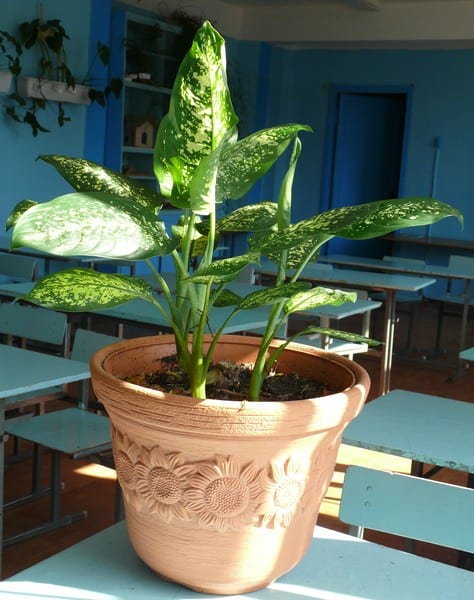

Care and feeding
Intensive growth of dieffenbachia is observed in the period from May to August, and therefore at this time it needs feeding with various fertilizers. For this, organic or complex mineral fertilizers are suitable, in which there is no lime. It has a detrimental effect on the dieffenbachia plant, and therefore it is necessary to choose top dressing without it.
You also need to remember that fertilizers with a high nitrogen content are not suitable for plants that have light spots on the leaves. This element causes a discoloration of light spots and stripes on the leaves, in which they turn green. In other words, in order for indoor dieffenbachia to have the original color color of the leaves, it is necessary to correctly select a top dressing with no lime and a low nitrogen content, and during the rest period, that is, from September to April, do not feed the flowers at all.
Brief conclusions
- Dieffenbachia is a tropical flower native to South America. Since it does not bush, but stretches out, it can only be given an appropriate shape by transplanting and pruning. All manipulations must be carried out strictly with gloves, because culture is poisonous!
- Plant pruning is carried out at the age of at least 2-3 years. It is performed if characteristic symptoms are found. If you carry out the procedure on time, you will be able to rejuvenate the bush and save it from developmental problems.
- A transplant should be carried out on time, otherwise there is a risk of developing diseases, a decrease in the decorative attractiveness of the flower. This is manifested in the fall and decrease of foliage in size, growth retardation, and rapid drying of the soil after it is moistened.
- After all the procedures, the flower needs competent care, it includes regular watering and high-quality feeding. If all the recommendations are followed, the plant will quickly restore strength, begin to grow actively, delighting the eye with lush, variegated foliage.
Dieffenbachia is one of the most common indoor plants, despite the whimsical care. Outwardly, the flower attracts with its rather large variegated leaves and creates a special atmosphere in the interior of your home. The variety of species of this plant makes it possible to choose the appropriate option for decorating the interior space.
If the flower stands in one position for a long time in relation to the sunlight, then it can bend, and the fallen lower leaves will make the plant unattractive. Experienced gardeners know how to prune dieffenbachia and they have the following tips:
Prepare in advance a sharp knife with small teeth (hacksaw), rubber gloves, alcohol, cotton pads, a glass jar with a volume of 0.5 liters, 2-3 tablets of activated carbon.
When cutting dieffenbachia, be extremely careful, since the juice released from the trunk and leaves is quite poisonous. Even after getting 1 drop on the skin or mucous membranes, it can provoke serious health problems. Therefore, you should put on tight gloves before pruning and periodically wipe off the juice that has been released with a clean cloth. Wash your hands thoroughly with an antiseptic when finished. One of the ways to stop the active release of juice is to stop watering the plant 3-5 days before the procedure.
There are no strict time limits for the pruning procedure, that is, it can be done at any time of the year as needed. However, do not forget that radical pruning of the stem dieffenbachia to the base of the root is carried out every 2-4 years, after which several full-fledged plants grow from the trimmed part, creating an excellent decorative effect.
The plant must be mature (trunk diameter at least 2-4 cm) and well-rooted. Be sure to leave small buds on the trunk, from which new shoots will subsequently begin to grow. The optimal number of kidneys is 2 or 5.
The sequence of actions for cutting is quite simple: make a strictly horizontal cut with a sharp knife, apply alcohol on a cotton pad and wipe the cut part to avoid the spread of harmful molds and bacteria, cover the stump with a jar, which should sometimes be lifted for airing. Remember to regularly water and fertilize the pruned plant as usual.
Dry the removed dieffenbachia tip for a day in open dry air, and then put it in water for further growth. By adding the crushed activated corner to the water, you will find the first roots in 2 weeks. If the trimmed part is rather large, then it is worth dividing it into several small ones and rooting it in a special soil intended for the flower.
Now you know how to prune Dieffenbachia and these tips will come in handy in the future to properly propagate the flower. The main reasons for the procedure for cutting a flower are considered to be excessive exposure of the trunk, yellowing and falling of leaves, loss of the decorative appearance of the plant. In general, the remaining tops of the plant take root quickly, and a gorgeous flower that looks like a thick bush grows from the cut trunk.
(2
rated, rating:
9,00
out of 10)
Dieffenbachia is one of the most popular indoor plants.
Despite the fact that it comes from South America, it can be successfully grown at home.
In order for the plant to be healthy and could delight for a long time with its attractive appearance, it is necessary to provide it.
Dieffenbachia description
Dieffenbachia belongs to the genus of evergreens from the Aroid family. Its wild relatives are native to the tropics of the Americas. The plant got its name in honor of the Austrian gardener Josef Dieffenbach. The indoor flower dieffenbachia is a tree-like plant with an erect trunk and a growth point at its top, which is why many species do not bush, and eventually turn into small trees. However, there are forms in which growth points are located along the stem, in accordance with which they give side shoots and resemble shrubs in shape.
The most remarkable thing about Dieffenbachia is its leaves - juicy, dense, dark green with various light creamy patterns - stripes or spots. The plant blooms very rarely, only if the growing conditions for it are ideal, and at the same time the inflorescence is an ear that appears in the axils of the leaves. The inflorescence is covered with a creamy blanket that is both protection and decoration. Dieffenbachia blooms for only a few days, and then the inflorescence dries up, and can be in this state for a long time. Under the right conditions, fruits appear from the inflorescences - berries with a bright orange-red color.
It must be remembered that dieffenbachia, which is grown at home, is a poisonous plant, the juice of which contains a certain amount of needle-sharp crystals of calcium oxalate. They cause dermatitis on the affected area of the skin or mucous membrane, as well as various allergic reactions and irritation. For this reason, it is necessary to keep it away from children or pets, and when leaving, use protective equipment.
Although the plant is poisonous, proper cultivation will not only not harm, but will also help create a favorable indoor climate. Dieffenbachia perfectly filters the air mass, while absorbing harmful impurities of benzene or xylene. For residents of large cities with the presence of industrial enterprises, it is imperative to grow dieffenbachia, because it will help purify the air and enrich it with oxygen.
Dieffenbachia transplant at home
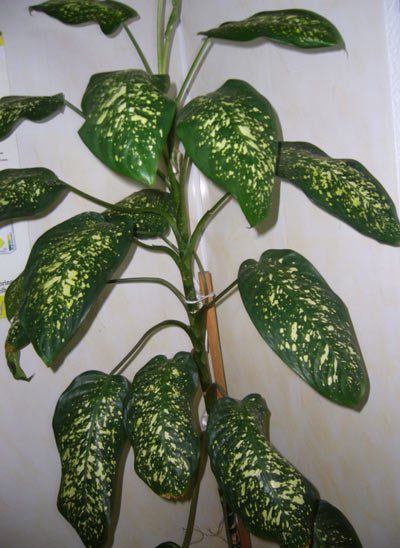

It is known that dieffenbachia does not bush on its own, but stretches in height.
To give it the shape of a bush, you have to do pruning and transplanting quite often.
But before transplanting dieffenbachia, you must first understand the reasons why this procedure may be required:
- the owner of the flower just wants to improve its appearance;
- the size of the plant does not correspond to the volume of the pot in which it is located.
If delayed with transplanting, the flower may begin to ache and lose its leaves. Finding out when the time has come for this procedure is very simple. To do this, it is enough to follow the behavior of the plant.
Transplant signals
- Decreased growth rate.
- Fast drying of the soil in the pot after watering.
- Reducing the size of new leaves.
If the plant, the development of which is accompanied by similar symptoms, is removed from the pot, then you can find a root that has grown over the entire space. Before planting, you need to prepare:
- new pot;
- materials for the drainage system;
- water for irrigation.
The pot should be 2-3 cm larger than the old container
.
Before placing a flower in a new place, you should carefully study the state of its root system.
Often, when growing in a confined space, the roots are intertwined, as a result of which some root processes die off.
Therefore, when transplanting a plant, you need to carefully clean the root of adhering soil and remove dead root processes. The trimmed areas must be treated with fungicide and charcoal.
In this way, the root of the plant will be protected from further decay. For transplanting, it is recommended to use neutral soil and new drainage. It is advisable to replant young plants once a year.
Description of a tropical plant
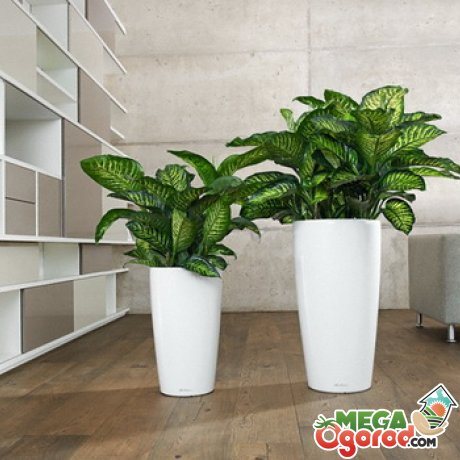

The indoor flower has a thick, fleshy stem, on which there are large ovoid leaves. Many plant species reach a height of one meter. They differ only in the color of the leaves:
- In spotted dieffenbachia, small yellowish spots are scattered on the dark green of the leaf plate. There are a lot of them in the middle, to the edge - they come to naught.
- Dieffenbachia Camilla has a bushy shape with small leaves. Originality in their colors: light middle and dark green edges.
- Lovely Dieffenbachia has beautiful symmetrical colors. Veins are drawn on the leaf plate in a light tone.
- In bush plant varieties, light stripes are drawn in the middle on oval-shaped green leaves.
- In a houseplant during the growing season, inconspicuous white flowers, collected on the cob, appear.
The Seguin hybrid has huge leaves with a diameter of fifteen centimeters. In addition to spotting, whitish stripes are visible along the veins.
For dieffenbachia, rapid growth is distinctive. The leaves appear so quickly that after a year or two, the top of the tree rests on the ceiling. At the same time, no leaves remain on the stem below. The decorative appearance of the tropical flower attracts many. By absorbing moisture from the leaves, the plant emits a lot of oxygen, helps to reduce the content of chemical compounds in the house. But there are so many of them that are distinguished by the materials used in the manufacture of furniture.
When is the best time to transplant?
Transplanting dieffenbachia at home is carried out in late winter or early spring. Otherwise, the plant may not take root. In the summer, they make a transfer only when absolutely necessary.
Important!
When transplanting a plant, it is undesirable to completely remove the soil from its root.
The flower must be carefully removed from the old pot and placed in a new place. This approach will allow him to quickly and painlessly get used to new conditions.
Fill the free space in a large pot with pre-prepared soil. Be sure to transplant prepare fresh drainage
.
Bloom
Dieffenbachia, with careful care and comfortable conditions, can bloom, because it is not in vain that it belongs to the aroid family. The buds are shaped like calla lilies and spathiphyllums: a long ear, surrounded by a light green or beige veil, with a massive thick core.
This phenomenon is characterized by a growth retardation, since all forces are spent on the ejection of peduncles. The lower part may be very exposed.
At home, this is a great rarity and most owners have never witnessed this miracle. It remains only to admire the photo.
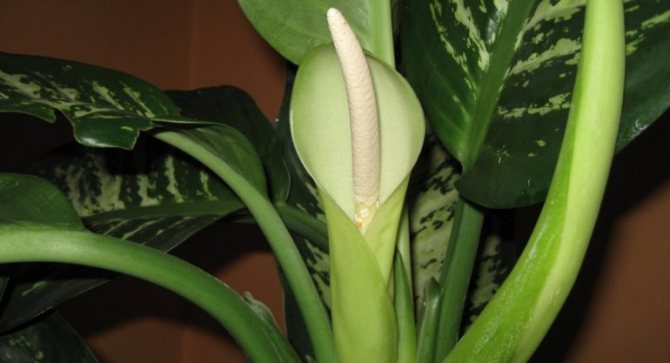

How to transplant long-stem dieffenbachia?
Sometimes it becomes necessary to transplant a plant with a long stem. As a result, its appearance becomes unaesthetic. This problem can be easily solved with circumcision.
When working with the trunk of an adult plant, you will need the following tools and materials:
- latex gloves;
- alcohol;
- warm water or soapy water.
Experts do not recommend cutting off a plant whose trunk has not reached 3-4 cm in diameter. To induce dieffenbachia to bush, the easiest way is to cut off the top. In this case, the dormant lateral buds will revive and the flower will grow in breadth.
The top of the flower can also be planted near the trimmed hemp, resulting in a beautiful and lush bush.Subsequently, the top will take root and can be planted in a separate pot.
Attention!
When circumcising dieffenbachia, a poisonous white liquid is abundantly secreted. Plant sap on the skin can cause severe burns. Therefore, during work it is necessary to protect your hands with gloves.
To reduce the amount of juice produced when the stem is cut, you can stop watering the plant in a few days
before pruning. If the trunk is too strong and cannot be cut with a regular knife, you should try using a wood saw.
Before pruning the instrument must be disinfected with alcohol
... At the end of the procedure, the working equipment should be washed to remove the remains of the poisonous juice.
This video shows how to transplant a large dieffenbachia flower into an auto-irrigated pot. In this case, a coconut substrate is used:
It is convenient to combine a flower transplant with its reproduction. in the following ways:
- seed;
- airy cuttings;
- stem cuttings;
During pruning, part of the stem removed is easy to use to plant a new plant. The long, removed stem can be cut into several pieces and deposited in separate containers with prepared soil.
Pruning
Pruning a dieffenbachia plant is needed when there are drying or broken leaves, but it must be carried out according to special rules. Since the plant is poisonous, it secretes sap that irritates the skin. Before removing unnecessary leaves, you should take a knife or a sharp blade and first wipe it with alcohol so as not to infect the plant tissue. With a clear, careful movement, cut off the spoiled leaf, moisten the cut with gauze or cotton wool to remove the juice, and sprinkle the cut with crushed coal so that it quickly becomes covered with a protective layer and does not emit poisonous juice. It is imperative to use rubber gloves to protect the skin of the hands from the effects of calcium oxalate crystals contained in dieffenbachia juice.
Rejuvenation of old dieffenbachia: transplant and circumcision
If the plant has taken on an unattractive shape, you can try to rejuvenate it. For transplanting and rejuvenating a flower, you will need the following materials:
- soft soil;
- shredded moss;
- peat mass;
- cleaned sand.
At the beginning of work, carefully cut the stem of the plant 3-5 cm above the flower node. It is better to do this at right angles so that the stump of the stem is even. The cut is processed using activated carbon. You can use a paper towel to dry it.
The trimmed part of the plant should be covered with a glass jar or piece of cellophane. It will not be superfluous to add a small amount of charcoal to the soil.
For a flower you need to choose slightly acidic soil with the addition of humus
.
If the land was bought in a store, you need to carefully study its composition.
Sometimes, for transplanting a plant, soil collected at the place where conifers grow is added to the ground.
The flower should be transplanted only into loosened soil. It is advisable to add peat and river sand to the new land.
Caution!
The soil in the pot should never be wet. Otherwise, the roots of the trimmed plant will begin to rot, which will lead to its death.
A prerequisite for transplanting dieffenbachia is soil sterilization.
After planting, the plant needs special care aimed at the earliest possible acclimatization in a new place. During the period until the young leaves have grown, the flower needs to be watered with small portions of purified water.
To speed up the growth of new shoots, you can stop watering for a few days. When new shoots begin to grow actively, you should feed the plant a little.But it is recommended to carry out this procedure in the autumn-winter period no more than once a month, in the summer - once every two weeks.
Breeding video of Dieffenbachia.
For the propagation of dieffenbachia, we need a sharp knife, since no chipping and burrs should be left on the cut. It must be remembered that Dieffenbachia is a poisonous plant, so you need to work with rubber gloves, especially if there are wounds or cuts on your hands. After finishing work, hands and equipment should be washed with soap and water. The video shows how to make a cut, how to root a cutting, and how to plant it. Happy viewing!
Instructions on how to trim dieffenbachia
In order to cut dieffenbachia you will need:
- hacksaw or knife with teeth;
- alcohol;
- ground cinnamon or coal;
- latex gloves;
- soap solution.
Pruning is recommended to be carried out on sufficiently mature plants, the trunk of which has reached a thickness of 2-3 cm in diameter.
Nothing will grow on a bare trunk, so cut as low as possible. Make sure that dormant buds remain on the stump. They look like holes or half rings. Better if there are 2-3 of them. A new stem will grow from each bud, and the plant will become very decorative in the future.
When pruned, dieffenbachia produces a lot of milky juice, which is very poisonous. Be sure to wear gloves. Remove small children and animals from the room while pruning. Even one drop of dieffenbachia juice that gets on the mucous membrane of a child can cause severe burns and anaphylactic shock.
To reduce sap production, stop watering the plant three to four days before your procedure.
Prepare the tool for the job.
Reproduction of dieffenbachia - video
Good day.
Today we will talk about what to do with Dieffenbachia if it stretched out and bent, because it was not turned to the light in one direction or another, and the lower leaves fell off due to cold drafts or improper watering. In such cases, the best thing that can be done to bring dieffenbachia to a beautiful appearance is to cut it off and root the apex. This is also called apical shoot dieffenbachia propagation.
Now we will just tell you how to properly trim the top of dieffenbachia, and how to root it.
We take a sharp knife and cut it just below the beginning of the bend. As a result, the curved part will be covered with a substrate, and this curvature will in no way affect the decorative effect of the newly transplanted plant.
It is worth remembering that the plant is poisonous, so you need to work with gloves, especially if there are cuts or not completely healed wounds on your hands. After working with the plant, you will need to wash your hands, and before that, try not to get them into your eyes or mouth.
Cut off. Just put the cut off top of Dieffenbachia on a newspaper on the knocks so that the cut point dries up. You can periodically blot the cut with a napkin to remove emerging juice. A day after pruning dieffenbachia, the apical stalk must be placed in water, and after two to three weeks, roots will appear at its base. You can throw an activated carbon tablet into the water. If the cut dieffenbachia has a long piece of the trunk, it can also be cut and rooted - the probability of successful rooting is very high. It .
Dieffenbachia is a tropical perennial ornamental deciduous plant that belongs to the Aroid family. This is an unpretentious plant, caring for dieffenbachia at home will be within the power of even a novice florist. You just need to learn a few simple rules and get acquainted with the features of the flower.
Instructions on how to trim dieffenbachia
In order to cut dieffenbachia you will need:
- hacksaw or knife with teeth;
- alcohol;
- ground cinnamon or coal;
- latex gloves;
- soap solution.
Pruning is recommended to be carried out on sufficiently mature plants, the trunk of which has reached a thickness of 2-3 cm in diameter.
Nothing will grow on a bare trunk, so cut as low as possible. Make sure that dormant buds remain on the stump.They look like holes or half rings. Better if there are 2-3 of them. A new stem will grow from each bud, and the plant will become very decorative in the future.
When pruning, dieffenbachia produces a lot of milky juice, which is very poisonous. Be sure to wear gloves. Remove small children and animals from the room while pruning. Even one drop of dieffenbachia juice that gets on the mucous membrane of a child can cause severe burns and anaphylactic shock.
To reduce sap production, stop watering the plant three to four days before your procedure.
Prepare the tool for the job. The trunk of an adult dieffenbachia woods, so if you work with an insufficiently sharp knife, you can grind it up. It is best to use a thin hacksaw or a well-sharpened knife with teeth for the job.
Treat the cutting area with rubbing alcohol to prevent bacterial or mold infections in the wound. After use, wash the tool thoroughly with detergent to remove residual juice.
The slice must be completely horizontal. Treat the cut with ground cinnamon or charcoal to prevent plant infection or rot.
The stump can be covered with a glass jar, which must be lifted regularly for ventilation. Reduce watering until the dormant buds wake up. After that, water and fertilize as usual.
The tip left after pruning can be rooted and later planted on the remaining hemp. In this case, you will end up with a large, lush bush.
If the cut is a long stem with a tuft of leaves at the end, cut it into several pieces. Dieffenbachia reproduces perfectly in pieces of the stem, even if there are no leaves on them.
Lighting and temperature control
This unusual flower with variegated leaves can be seen in many houses and apartments, where it forms a single composition with orchids, ferns and other flowering crops.
Where to place Dieffenbachia so that it grows healthy and beautiful?
What rules should be followed when growing it? The best place for the plant would be a window with a bright but diffused light so that direct sunlight does not harm its leaves, which can become small and lose their variegated colors. And such a place for a flower is - the east, west and north sides of the house. If all windows in your house are southern, then it is better to cover them with curtains. In winter, the flower also tolerates partial shade. If you decide to place it far from the window, you need to provide additional lighting for it.
In spring and summer, the optimum temperature for a flower is 20-22 degrees, but even if it is slightly higher, it will also tolerate heat well, provided that you can maintain high humidity in the room with frequent spraying. In winter, it is better to keep this culture in a cooler room with a temperature of 15-18 degrees. At lower temperatures, it can lose lower leaves. She also does not tolerate sharp drops or increases in temperature.
Conditions for growing a tree culture
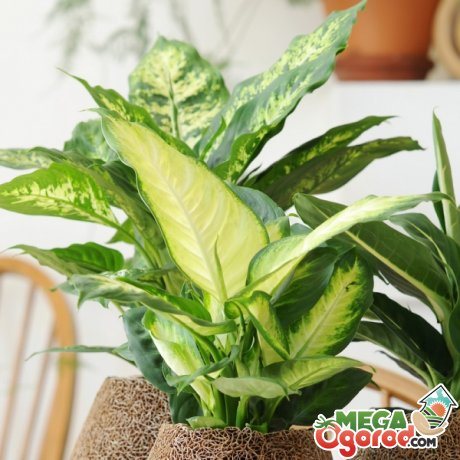

For tropical dieffenbachia, create the conditions necessary for active growth:
- A lot of light is important, but without direct sunlight. Therefore, it is better to place a pot with a plant in the southwest or southeast part of the house. Determine the lack of light by the way the leaves look. If the number of light spots decreases, and the plate becomes uniformly green, then the plant needs illumination.
- The room temperature range for an indoor flower is 18 to 25 degrees above zero. In summer, you can put a dieffenbachia pot on a glazed loggia or veranda. The heat in the room will lead to drying of the leaves, flying around it.
- Drafts, sudden temperature changes should not be allowed, otherwise the beauty will remain without leaves.
- The soil is selected with moderate acidity.
- Given the rapid growth of the bush, a large pot is needed for a flower.
- Tropical air is always saturated with humidity. This is important for the plant. Therefore, he is satisfied with regular spraying. When the room temperature drops, the shower is replaced by wet leaf treatment. After moistening a soft cloth in warm water, gently wipe the surface of the sheet with it.
Read also Geranium max fry photo
The conditions created will have a positive effect on the correct development of dieffenbachia.
How to care for dieffenbachia?
Dieffenbachia home care for which consists in optimal conditions of detention, timely watering and feeding, grows very quickly. Every week a new sheet appears on it. For several years, tall plant species grow up to two meters, and small ones - up to a meter. Despite its unpretentiousness, Dieffenbachia does not like drafts and low temperatures, it needs proper watering and pruning.
Watering
How to water dieffenbachia? The soil in the flowerpot where the plant is planted should not dry out and the flower should be watered regularly. Watering dieffenbachia depends on the season:
- in winter it should be moderate and should be done as the soil dries, once every 7 days;
- in spring and summer, the soil in the pot is watered often - 1 time in 2-3 days. Once a week, a culture can have a warm shower.
Before watering, the water must be defended for at least two days. It should not be cold, as this will damage the roots of the plant. If the leaves of the plant turn brown, the water has increased hardness and a little oxalic acid needs to be added to it. Softer water for irrigation will be rain and snow. It is very important to maintain a balance of water in the soil so as not to cause rotting of the root system. No less important for the bush and moisture. If the air in the room is too dry, the flowerpot is placed in a pallet with wet sand, gravel or moss, or a container of water is placed next to it. Dieffenbachia leaves are wiped with a damp cloth.
Pruning and updating the plant
As it grows, the flower loses its lower leaves and its trunk becomes bare, which means it needs pruning or renewal. How to trim dieffenbachia? Cutting the bare stem of the bush should be carried out with gloves, as the sap of the plant is poisonous and can cause irritation. The stem is cut to a height of 10 centimeters from its base. After a while, new young plants will appear on it.
Young flower care
In the first year of life, it is better to install the bush on the windowsill of the western or eastern window. In order for it to develop correctly and not lose its decorative effect, it is necessary:
- water and spray the flower regularly;
- turn it from time to time so that its trunk is straight and develops evenly from all sides;
- feed with fertilizers containing potassium, reducing the indicated dosage by 50% (before feeding, the flowerpot must be well watered so that the fertilizers do not burn the roots).
Comfortable conditions
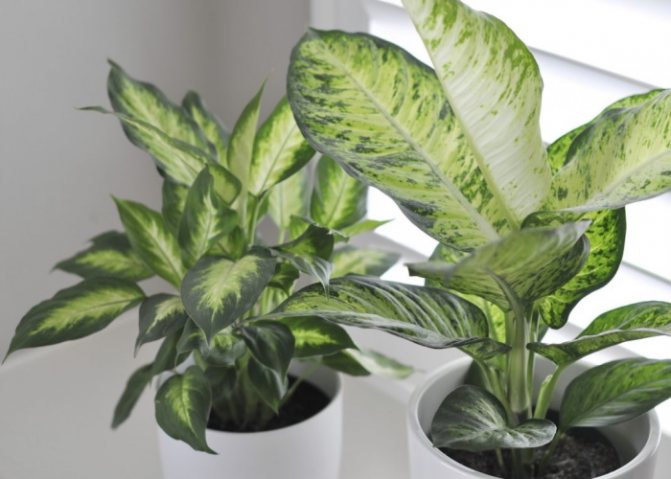

As for the conditions for growing dieffenbachia indoors, one of the main factors for the correct healthy growth of plants is air humidity. Since its wild relatives grow in tropical climates, indoor specimens are demanding for high humidity, and therefore they must be regularly sprayed with a spray bottle. If this is not done, the succulent leaves of the plants will soon dry up and turn yellow at the edges, and soon they will begin to fall off. In addition to spraying, you can place the pot on a pallet with wet gravel, and then the fumes will maintain a normal microclimate for the plant.
Watering
Watering dieffenbachia with proper care should be abundant during the period of active growth - from spring to autumn, and in winter it must be reduced. It should be remembered that excessive watering and stagnation of water in the pot can adversely affect the state of the plant, and its leaves will turn brown and fall off at the edges.
Temperature
The temperature regime of the environment is also important for dieffenbachia - it grows well only in warm climates, and therefore it is necessary to maintain a temperature of + 18 + 21 ° C in the room. If it becomes much lower, then the plant will immediately react to the change - its leaves will turn yellow and rot, and if it is kept in such conditions for a long time, dieffenbachia will completely die. It is also necessary to protect the plant from drafts, since it is afraid of cool air.
Lighting
The illumination of the space in which the dieffenbachia is located should be stable without direct sunlight or strong darkening. The ideal location is considered to be the west or east side, on the south it will quickly burn out in strong sun, and on the north, in the absence of sufficient light, it will stretch out and become fragile, and its leaves will become smaller. Also, with insufficient illumination, light spots on the leaves of all varieties turn green over time, which reduces the attractiveness of flowers.
Reproduction methods
You can keep new young plants for yourself if the old bush has lost its decorative effect or make a gift to your friends and family. How does dieffenbachia breed? Dieffenbachia can be propagated at home in several ways: by cuttings, by rooting a piece of the stem, and by the method of forming new shoots on the old trunk. The second method is considered quite laborious.
When rooting with the help of pieces of the stem, those with dormant eyes are selected. They are placed horizontally in a container with soil and deepened by half. Before planting, the sections of the stem must be treated with charcoal and dried. The first shoots on them may appear not earlier than in 8-12 months.
How to grow a new plant from the leftover old trunk? What to do if you have a small trunk of an adult plant, and the cuttings from it or part of the stem did not work out to root? If dormant buds remain on the trunk, then after a while they may wake up, and you will get a new plant that needs to be carefully cut (when they have the first roots) and transplanted the cut trunk into a new flowerpot.
How to root dieffenbachia if you have pruned it and you have its apical stalk? Propagation of dieffenbachia by cuttings is considered a fairly simple method. They also call it “rejuvenation” of the plant.
The cut off top of the flower is placed in water or potting soil. Add 1-2 tablets of activated carbon to a container with water where the cutting is placed, this will prevent the stem from rotting. Dieffenbachia, which is propagated in this way, gives roots very quickly. It must be planted carefully, since the young roots are very fragile and can be damaged. Self-grown, it will be the pride of every grower, no matter which breeding method you choose!
How to transplant dieffenbachia?
How to transplant Dieffenbachia correctly? Dieffenbachia is transplanted every year, adult plants - once every 2-3 years. This should be done in the spring, at the end of April. The soil for the flower should consist of:
- four parts of sod land;
- one part of peat;
- one part of leafy soil;
- one part of the sand.
One of the famous florists, V.V. Vorontsov. recommends this potting mix:
- two parts of sod land;
- one part of peat;
- one part of leafy soil;
- and half of one piece of sand.
How to plant dieffenbachia with the least injury? The plant can be transplanted, but you can also "roll over" by wetting a clod of earth and carefully pulling it out of the old flowerpot, so that the clod does not fall apart and the roots are not exposed. The latter method is considered the most gentle and does not allow the plant to hurt after planting.
What to do with a cut trunk?
The trimmed remains are used for propagation of dieffenbachia. In this case, not only the top is rooted, but also the long trunk itself:
- Rooting of the apex. Put the cut off crown in a glass of water and wrap it with a dark cloth so that it does not become enlightened. The water is changed every 2-3 days. After the young roots appear, the top is planted in a pot to a cut dieffenbachia or in a separate bowl as an independent plant. You can immediately root it in a mixture of earth and sand.
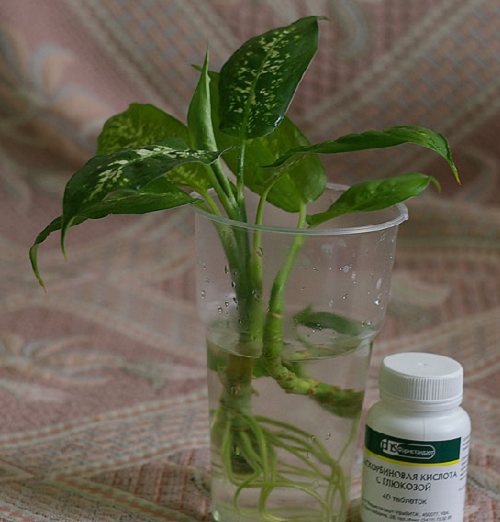

- Rooting the trunk. Cut the long stem into pieces so that buds remain on each. Leave to dry for 2 days at room temperature.
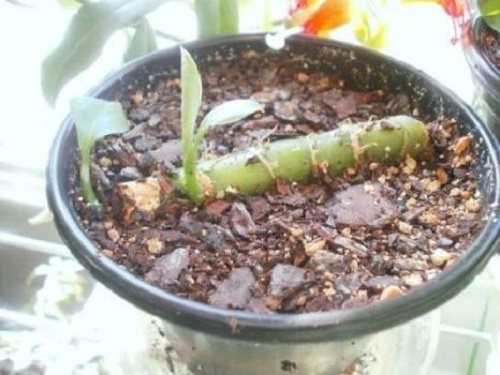

Dieffenbachia rejuvenation by trimming - video
Diseases and treatments
Failure to follow the rules for caring for the plant, you risk its health, since improper or untimely watering, disturbed temperature conditions and insufficient air humidity, which are so important for dieffenbachia, can cause various diseases and pest damage.
Why do dieffenbachia leaves turn yellow? What can cause such changes and what can be done to save the diseased flower?
The pests of this culture are a soft false shield, a mealybug.
The soft scabbard settles on the upper part of the leaves and stems of the plant. The leaves of the bush begin to curl and fall off, and the appearing companion of the scale insect, the twill fungus, can completely destroy it. To prevent this from happening, when this pest appears, remove it from the leaves with cotton wool dipped in alcohol or soapy water. After processing, the humidity in the room must be increased, and the plant itself must be placed in a dark place. The mealybug, which settles on its leaves, branches and flowers, is also a dangerous pest of a flower. The trunk of the bush, like the leaves, is deformed and then dies. They fight him in the same ways as with a false shield.
If the leaves of dieffenbachia turn yellow, then this may be caused by too low a temperature in the room, or due to an emerging disease - root rot. If yellowness appears at the bottom of the plant, and its lower leaves have withered, then you need to raise the temperature in the room or remove the flowerpot from the draft.
Root rot, which causes yellowing of the leaves underneath, appears due to over-watering of the crop and high acidity of the soil. And if the leaves of your Dieffenbachia become yellowed, and the plant itself has stopped growing, it must be removed from the rest of the plants. If the plant is damaged by stem rot, it can still be saved with rooted upper cuttings. They can be planted in new soil, with the addition of activated carbon, which will prevent them from rotting. If the leaves fall off and their browning or loss of color, first of all, adjust the keeping mode of your green pet.
Propagation by cuttings and layering
Dieffenbachia propagation is carried out using cuttings. This is the most convenient and reliable way. It is easiest to use it when you need to update an old trunk that is bare from age. In this case, carefully cut off the top and blot the cut with a paper towel. Then, for rooting, the tip is placed in water or wet sand. The stalk must be protected from direct sunlight, constantly sprayed so that it receives enough moisture. The temperature should be high enough.
Reproduction by stem cuttings is also possible. To do this, the bare trunk in the pot must be divided into pieces with a knot in the middle. They should be left for a day to dry. Then put on moistened peat mixed with sand, with the buds pointing up. After that, cover with foil and wait for rooting to be transplanted into ordinary soil. The tree stump can also be used: if watered well, it will sprout from the remaining nodes. When a couple of leaves have grown on them, the shoots can be cut and replanted for rooting.
Reproduction can be done by air layers.This is a bit more time-consuming process, but sometimes it is rational to use it. A small incision is made on the stem, covered with moistened moss and wrapped in foil. It is fixed with tape, thread or electrical tape. After some time, roots will grow under it, then this section of the stem is cut off. The film is carefully removed, and the layers with moss are planted in the soil.
Growing these indoor plants is not easy. Dieffenbachia care includes regular transplanting, pruning and breeding. "Green friends" require increased attention to themselves, adherence to the temperature regime and maintenance of the desired humidity level. But they do an excellent job of purifying the air from a variety of harmful substances: formaldehyde, xylene, benzene and others. They will be most useful in the kitchen. It is there that it is worth highlighting a place for a flowerpot.
Read the article: storing grape cuttings in winter
Rooting soil
As we already know, this decorative flower can be propagated by rooting cuttings cut from an adult plant. In order for the cuttings to give roots, they are placed in a nutrient medium - soil or water. In order for the cut trunks of dieffenbachia to acquire their own roots, place them in a container filled with water or earth.
The easiest way is to root the cuttings in water, for this:
- fill the jar with water and dissolve a couple of activated carbon tablets in it;
- to provoke the formation of a root system, place the cuttings in water;
- put a jar of water and cuttings in a bright, warm place with a temperature of 21 to 24 degrees above zero;
- so that fresh roots do not rot, periodically change the water to fresh. This procedure should be carried out at least once a week.
The first roots will appear approximately one to two weeks after the cuttings are placed in the aquatic environment. It will be possible to plant new plants in the soil only when the roots reach two to three centimeters in length.
To speed up the growth of the root system, you can add a few drops of aloe juice to the water. This common agave is able to activate the internal forces of dieffenbachia, which will lead to the rapid growth of roots and the awakening of dormant buds.
Nutrient substrate
It is possible to induce the growth of the root system in cuttings not only with the help of water, but also using nutrient soil. To do this, it is worth preparing a suitable soil, it should be lighter than the planting soil, which is used for the constant cultivation of flowers. We offer two soil compositions for rooting cuttings. First:
- 0.5 kg of peat soil;
- 500 g soil baking powder.
- 250 g of peat soil;
- 0.5 kg of sphagnum;
- 250 g baking powder.
Use vermiculite or perlite as a loosening agent. The earth, prepared from such ingredients in the correct proportions, turns out to be very light, and most importantly, it is breathable. In such a substrate, young roots will quickly grow and can germinate through it.
To prevent the cuttings from starting to rot, which is a frequent occurrence when rooting in the soil, add crushed activated charcoal or charcoal to the soil.
Cut cuttings should be dried before placing in the ground, after which they can be buried in the soil. To do this, they are lowered into the ground to a depth of about four to six centimeters (two to three knots). In winter, the process of root formation may take a long time or not start at all if the cuttings start to rot. To accelerate the growth of roots at such a time of year, it is recommended to place the cuttings for ten hours in a solution of "Kornevin" (heteroauxin) before planting. After that, they are planted in moist soil.
If your cuttings are small in size, and their length does not exceed 10-15 centimeters, then after deepening, you can organize a home greenhouse for them. To do this, cover the plantings on top with cans, foil or glass.
Read also: Blueberry variety Northland: description, care - Garden Botanica
The cover of an improvised greenhouse must be transparent. This will provide the cuttings with high humidity and a constant temperature, that is, they will be in a greenhouse environment. This effect will provide cuttings with high rooting chances, which is especially useful in winter, when the plants are not tuned for vegetation and root growth. In the spring and summer, such tricks can be abandoned.
For rooting dieffenbachia, it is best to use loose soil and small, separate containers. Plastic cups or cut-off bottles are perfect for this.
It should be borne in mind that cuttings rooted in the soil require special care:
- correct watering. Until the branches have a root system, they should be watered very carefully, otherwise you can provoke rotting of the planting material. Therefore, consider the following rule - watering is done only when the soil around the buried cutting is dry;
- spraying. It is rather problematic for stems without roots to absorb moisture from the soil; through the foliage they do it more willingly. Therefore, once a day, plant leaves (if any) should be sprayed with plain water from a spray bottle. This procedure will help young Dieffenbachia get started with root growth and overcome the stress of transplanting.
Acclimatization and transplant after purchase
After the purchase, dieffenbachia must adapt to the new conditions. In order for the plant to acclimatize safely, it is recommended to adhere to the following rules:
- put the purchased plant in partial shade with a temperature of +18 ° C;
- if dieffenbachia was bought in the winter season, you should not immediately put it in a well-heated room, despite the fact that it is adapted to a hot climate;
- if the soil in the pot is dry, abundant watering is necessary;
- after 40 minutes, pour the excess water out of the pot.
The transplant can be carried out only after 10-14 days from the date of purchase. In this case, it is necessary to choose a pot that matches the size of the plant's root system. It is not recommended to transplant the shrub into a large container in order to avoid waterlogging of the soil.
It is worth replanting dieffenbachia acquired in the autumn-winter period from February to May.
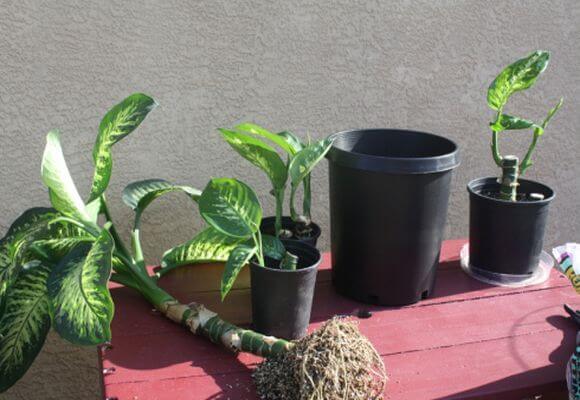

Plant features
It should be borne in mind that even with good and proper care, these representatives of the aroid family on the slopes bare the trunk with age, dropping foliage. On average, a dieffenbachia leaf stays on the plant for about two years, and then turns yellow and falls off. Fresh leaves are located at the top of the flower, and the oldest ones are at the very bottom. With age, they fly around, which leads to the exposure of the trunk. For dieffenbachia, this is a natural process, it proceeds equally both in the natural environment and when grown at home.
To deal with such an unpleasant feature is possible only with the help of plant rejuvenation. This is done by grafting an old flower that has lost its decorative properties. Thus, fresh and young dieffenbachia can be obtained from one plant that has become unusable.
This procedure can be called in different ways, depending on the goals pursued. If cuttings from the top are used during grafting, then it is called rejuvenation. If several new plants are grown from different parts of one old dieffenbachia, then the process is called reproduction.
Care Secrets and Tips
In the first year of life of a young Dieffenbachia grown from a cutting or leaf, the plant should be placed on the east or west windowsill, providing it with diffused light. Watering is necessary only after the top layer of the substrate is completely dry. To keep the stem straight, dieffenbachia periodically needs to be unwrapped so that all parts of the plant receive enough sunlight.In order for the flower to feel comfortable and look attractive, you need to apply fertilizer to the soil a couple of times a month. Dieffenbachia is very fond of spraying leaves and taking a shower, because this flower is tropical, and in nature it grows in high humidity conditions.
You should always remember that Dieffenbachia is a poisonous plant, so it does not need to be placed in the children's room and where there are pets. You need to cut and propagate this flower with gloves so that the plant sap does not get on the skin.
Plant varieties
The most common types of flower are Seguin's Dieffenbachia and Spotted. The first is decorated with a marble pattern on dark green leaves with streaks, streaks and specks. In length, the leaves can reach 60 cm with proper care and provided that the soil for dieffenbachia is selected taking into account all requirements.
The foliage of the second popular variety is decorated only with ivory spots and specks on a dark green background. Sometimes the pattern can merge, forming a completely lightened middle on the surface of the sheet. The size of oval leaves with proper care reaches 70 cm.
Less common among domestic connoisseurs of indoor flowers are the Baumann, Bause and Oersted dieffenbachia. Their leaves have a unique pattern and shape, and the height of the entire plant can vary from 80 cm to one and a half meters.
Propagation by dropping
Amateur flower growers with sufficient experience and skills practice such an original way of reproduction and renewal of a decorative culture, such as dropping in the apical shoot of an adult plant. In this case, the stem part of the stem with the presence of buds is laid flat and instilled. With the correct implementation of the event, not one, but several young plants sprout in one row at once, which looks very attractive and impressive.
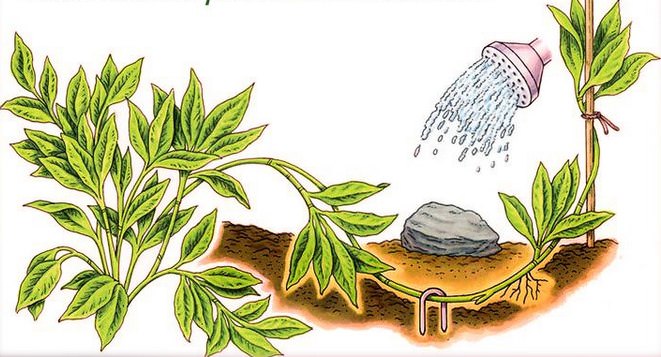

Possible growing problems
All amateur flower growers know how to care for dieffenbachia. However, not everyone understands why the plant can get sick. The most common symptoms of trouble are:
- Yellowing of the leaves;
- Pale color of leaves;
- Drying;
- Falling foliage.
Each of these disorders has its own cause, so they need to be treated differently.
Leaves turn yellow
Not everyone knows why dieffenbachia leaves turn yellow. This is most often caused by root decay. Reducing watering in most cases helps to save the situation. Also, the leaves can turn yellow if you plant dieffenbachia in a cramped pot.
Leaves turn pale
If dieffenbachia leaves turn yellow, the reasons may be different. If the leaves turn pale, it is most often caused by a lack of nutrients. As an "ambulance", the plant needs fertilizing with complex mineral fertilizers.
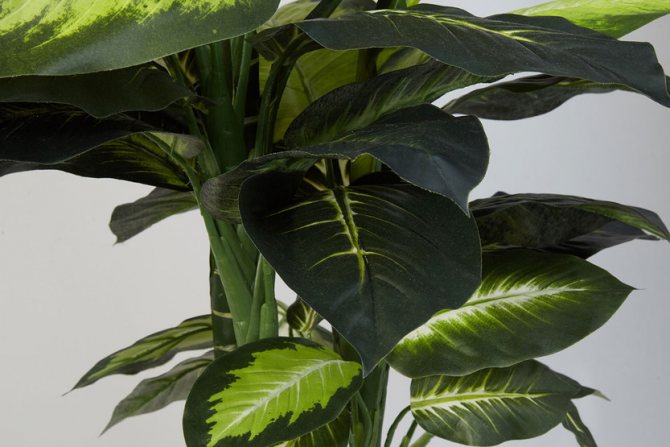

Leaves may turn pale from lack of nutrition
The tips of the leaves dry
Drying of the tips is an alarming symptom, signaling stem and root problems. In this case, you can save the flower by performing a transplant and removing some of the diseased (rotten) roots.
The lower leaves fall
If the lower leaves begin to fall off, curl and dry, a fungal or viral infection is to blame. Industrial fungicides can be used to combat the disease, and pruning also has a healing effect.
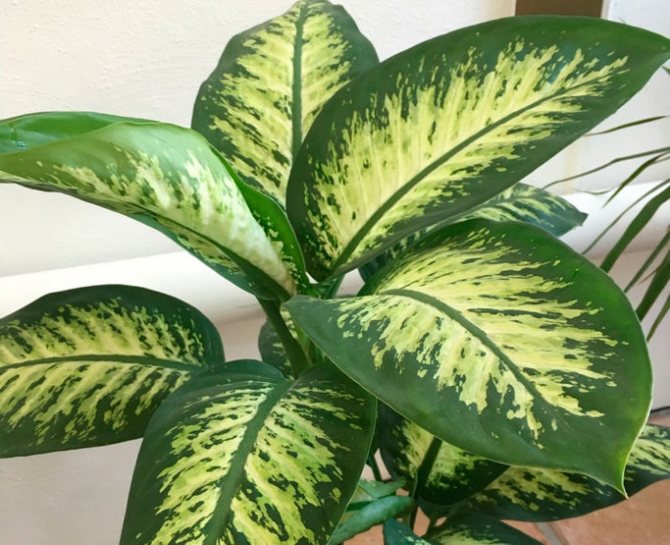

The falling of the lower leaves indicates a fungal infection.
Pests
Dieffenbachia rarely becomes a prey for pests, insects are repelled by poisonous milky juice. However, the plant can be attacked by a scale insect. It can leave mucus on the leaves, as if the flower is "crying" with real tears. Spraying should be used to combat it. Also, the scale insect loves dust, so you need to wipe the leaves with a damp cloth as often as possible and arrange a powerful "shower" for the flower.
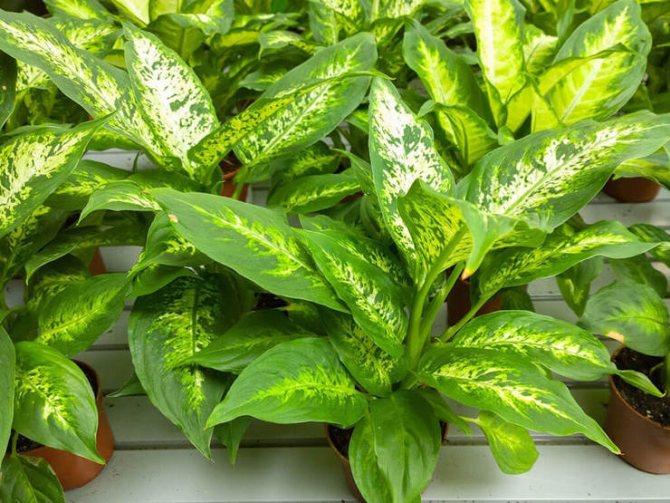

The best way to control pests is mechanical
Interesting! The best way to collect scabbards is by hand.Dieffenbachia does not always respond to industrial insecticides, and the mechanical method is guaranteed not to give a result. The parts of the plant affected by the scab are immediately destroyed by burning.
Other problems
Other problems include viral leaf mosaic disease. The foliage changes its color, whitish and yellow spots appear on it. Destroying and burning affected leaves and stems will help reanimate the plant, no matter how sick it may seem.
This flower is good because it quickly adapts to any conditions. However, flower growers should be aware of its toxicity; such a plant is better suited for the office, and not for the home. Carrying out care, you should pay special attention to the correct feeding. The rapid development of the plant at home largely depends on it.
Diseases and pests of dieffenbachia
Of the pests, indoor shrubs affect:
- thrips;
- spider mites;
- mealy worms;
- shields and false shields.
In conditions of high humidity, rot and various fungal diseases may appear on the plant. To reduce the risk of infection, you should regularly treat the soil with a weak solution of potassium permanganate.
Mealybug
When dieffenbachia is affected by a mealybug, cotton-like flakes appear on the leaves and soil. Processing should be carried out both on the green and in the underground part of the bush. It is recommended to clean the plant with Aktara or Mospilan 3-4 times a week every 10 days.
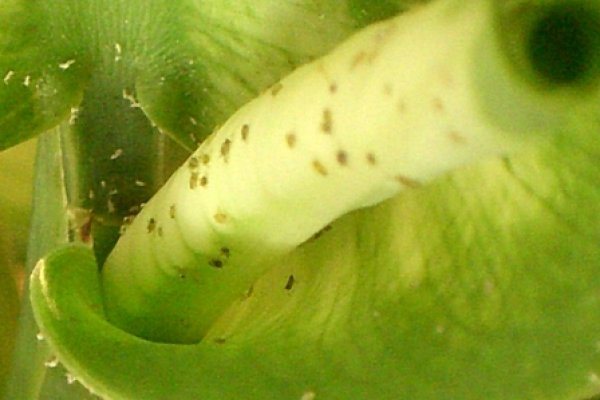

Spider mite
You can guess about the appearance of a spider mite by the dried edges of the leaf plates and an invisible cobweb on the underside of the leaves. To eliminate the pest, multiple pesticide treatments will be required. To get the maximum effect from a chemical or biological preparation, it is worth covering the plant with a bag for 24-48 hours. The procedure must be repeated 3 times every week. During pest control, you need to regularly clean the room.
Shield
Shields or false shields are distinguished by the presence of a round exoskeleton in adults, which firmly protects insects from disinfecting the plant with chemical preparations. At the same time, you can get rid of the pest with the help of the usual bathing of dieffenbachia in the shower and wiping the leaves with soapy water. To prepare the latter, you need to grate a bar of laundry soap and dissolve it in 1 liter of water. Unlike other insects, adults cannot move. Movements between plants are carried out by the larvae of the scale insects.
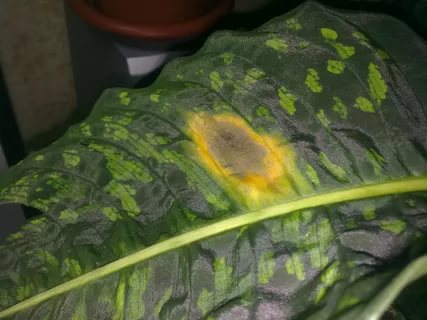

How to propagate with air layers
Another way of propagation of dieffenbachia: air layering.
- An incision is made on the trunk with a sharp, sterile knife, fixed with a sliver and wrapped around with wet moss.
The incision is fixed with a splinter - Cellophane is tied from above.
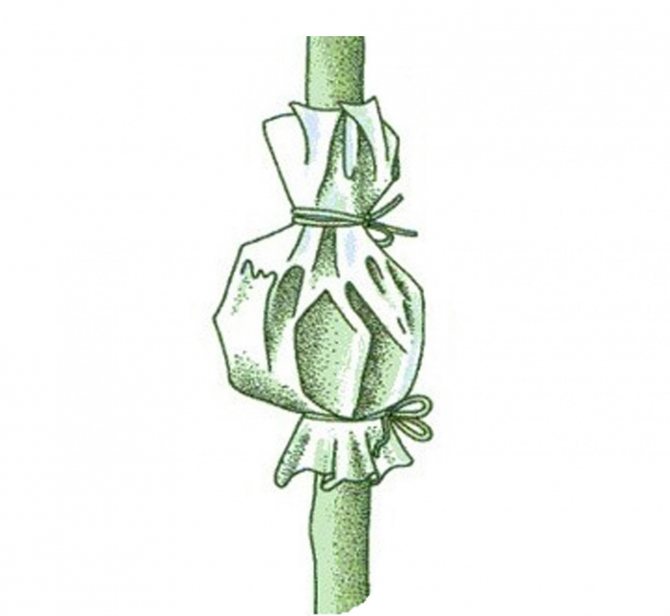

From above the moss is tied with cellophane
- It is necessary to check the moisture condition of the moss 1-2 times a week and, if necessary, moisten it with a spray bottle. Kornevin can be added to the water for spraying at the tip of a knife for half a liter of water.
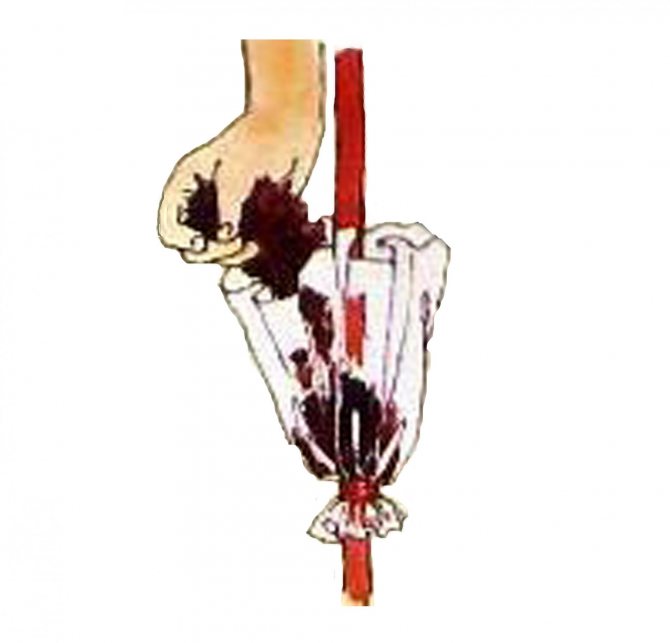

It is necessary to check the condition of the moss and the presence of root formation
- When the roots appear, the trunk is cut off and planted in the soil in the usual way.
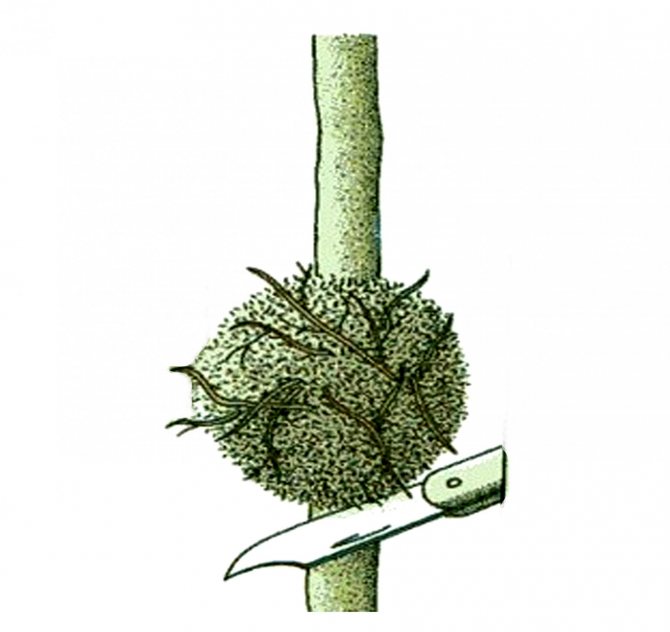

The trunk that has given roots must be cut
Another method of propagation by air layers has a slightly different scheme. Instead of moss and cellophane, a kind of pot with a substrate from a light mixture is attached to the cut. For example, sphagnum + soil + perlite.
The pot is attached with sticks to the trunk.
You can use peat as a pot or cut from a plastic bottle.


Method of propagation by air layers with a substrate
General characteristics
To find out exactly which soil for dieffenbachia will be the best, you need to understand the other features of the plant. The homeland of the flower is the islands of the Pacific Basin and the south of North America. In natural nature, the plant can reach six meters in height, but in apartments it rarely grows above two meters.The shape and color of the leaves depend on the variety.
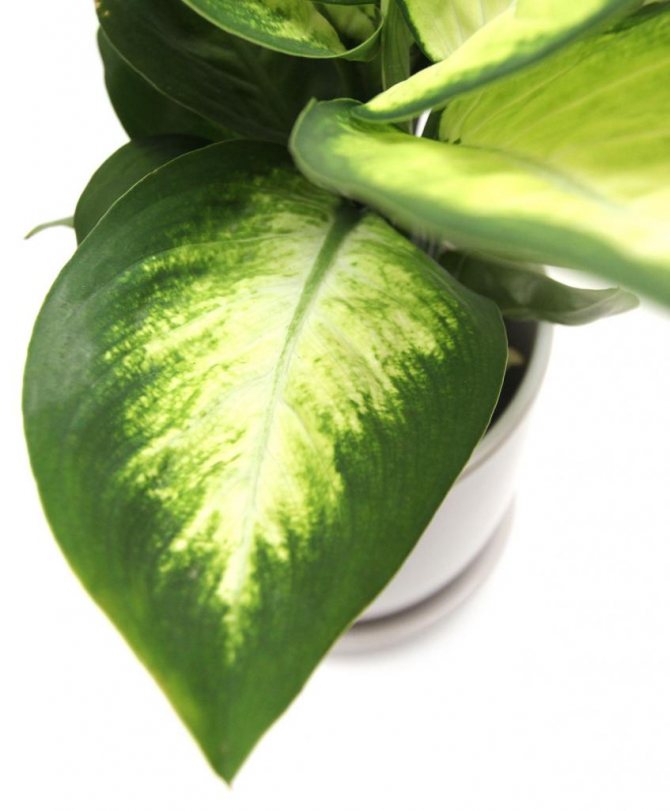

The plant is recommended to grow in rooms facing highways, factories, factories or railways, since Dieffenbachia perfectly cleans the air. In this case, the plant is poisonous and can cause swelling of the larynx or irritation on the skin and mucous membranes in direct contact with the juice. Based on this, in a house where there are small children or animals, the flower should be placed in a sufficiently protected place. In the home, the plant practically does not bloom, but it can release a bud in early spring. It is especially poisonous, like the bright berries that appear on Dieffenbachia afterwards.
Reproduction by apical layers
In addition to the methods described above, dieffenbachia can also be propagated (like ficus) using aerial roots.
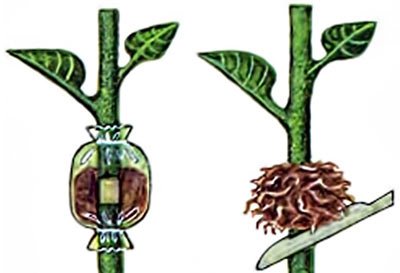

The order of this procedure is as follows:
- Make several small cuts on the trunk.
- Cover them with moistened moss and, wrapping them with an opaque film, secure the structure with a thin rope.
- Always moss the moss until the roots "peck".
- When roots appear from the drainage holes, cut off this part of the stem and, removing the film, plant the segment together with the moss in the ground. As a result, you can get a composition of several fluffy bushes.
Stem propagation
A distinctive feature of dieffenbachia of any kind is high decorativeness, and you can get a new plant yourself as soon as possible by propagating the culture with a stem. The plant propagates in this way, if necessary, to rejuvenate adult, fully formed ornamental plantings, on which there is a gradual drying out and falling of the lower foliage.
In this case, the stem part, which has a growth point, is cut off. Most often, the trimmed stem is simply dropped into the nutritious potting soil and watered abundantly. It is necessary to fill it abundantly with water, and then wait until it takes root. The nutrient substrate can be a special soil for growing a houseplant or a mixture based on peat and medium-grained sand.
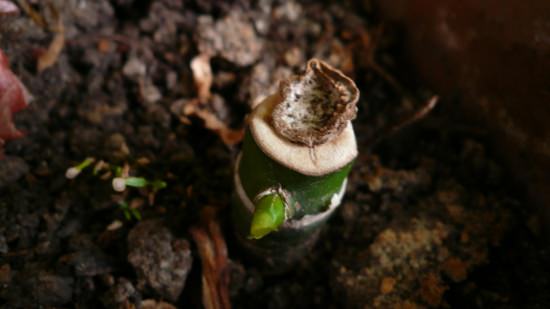

Twig breeding
The top or processes are cut and cut into cuttings, about 10 centimeters long, so that there are several internodes on each cuttings. If the tip is used for rooting, then you do not need to remove the leaves from it. It is only necessary to cut the cuttings with a sharp, disinfected instrument. After cutting off the appendix, it must be dried in the air for about 3-4 hours, more is possible. It is advisable to treat the cuts with crushed coal or Kornevin. After cutting, the cuttings are best rooted in water. In a jar of water, you first need to dissolve one or two tablets of activated carbon, then put the jar in a bright, warm room. The water in the jar needs to be changed about once a week so that the stalk does not rot. When the roots reach a length of 3 centimeters, the branches can be transplanted into the ground. The substrate for planting the top of dieffenbachia or its processes should be light and loose. You can use a one-to-one mixture of peat soil and vermiculite, and some growers mix peat soil, sphangnum and perlite. In such a mixture, the roots germinate very quickly. Some growers advise to lay the cutting horizontally on the ground, and cover it halfway with earth, thanks to which the leaves will appear on the entire stem. You can also plant a shoot or stalk at an angle or vertically, it doesn't really matter. The container in which dieffenbachia is grown must be covered with a lid or plastic bag. Thanks to this, greenhouse conditions are created where there will be a constant temperature and sufficient humidity, where the cuttings will take root much faster. In the summer, the container can be left uncovered. As long as the branch has no roots, watering should be small and gentle so that the cutting does not start to rot.If there are leaves on the branch, then it is advisable to spray them with water once a day, thus, the branch will grow roots faster. If the lower leaves on the cutting turn yellow or dry out, then this is not a cause for concern, the plant just gets rid of unnecessary elements that require nutrition. The yellowed leaves must be cut off. For propagation of dieffenbachia, both the top and the bare trunk can be used. It must be cut and divided into several small cuttings, 5 to 10 centimeters long, these cuttings must be rooted in the same way as the branches, the main thing is not to confuse the top and bottom of the trunk. To make planted cuttings from the trunk look aesthetically pleasing, they can be laid horizontally on the ground and deepened by half. After the trunk is rooted, it can be completely covered with earth.
How to choose dieffenbachia in the store
Before purchasing, you must inspect the plant for yellow leaves. You will need to assess the state of the green part of dieffenbachia. There should be no stains, damage or deformations on it.
It is recommended to pay attention to the lower leaves. Yellowed, limp, or damaged shoots are not viable and should wither soon. A similar situation occurs when there are broken veins through which the leaves receive nutrients. Dieffenbachia should have fresh and juicy greens.
Basic breeding methods
How to propagate dieffenbachia? This can be done vegetatively and by seed, namely:
- cuttings;
- rooting of leaves;
- lateral processes;
- seeds.
This plant is propagated by seeds quite rarely, since it is almost impossible to get seeds at home due to the fact that dieffenbachia blooms very rarely in apartment conditions. Seed propagation is a way for specialists and breeders, thanks to it, new varieties of flowers can be developed. Therefore, dieffenbachia is almost never propagated by seeds.
Propagation of dieffenbachia by cuttings
This is the simplest method of growing a flower, which is usually chosen by novice growers who have no experience in growing this plant. For breeding, you can take stem cuttings, apical, as well as lateral processes. Reproduction by lateral shoots is very rarely used, because lateral buds begin to wake up very rarely, and in indoor conditions, lateral shoots usually do not appear in the plant. Therefore, the best, often used material for propagation is the apical cuttings, as well as stem cuttings.
Types and varieties of dieffenbachia
Botanists classify more than 40 types of dieffenbachia, of which about 10 are grown at home.
Dieffenbachia leopoldii
Leopold is rarely found among indoor flowers. This type of dieffenbachia is cultivated from the jungles of Costa Rica. The plant is distinguished by its exotic appearance: the trunk of the culture is short, does not reach 5 cm in length. At the same time, a fleshy stem grows in diameter up to 2 cm. Wide elliptical leaves are painted in a dark green hue. The central vein of the leaf stands out clearly due to its white color. The petioles are short and inconspicuous, painted in a pale green color with purple dots.
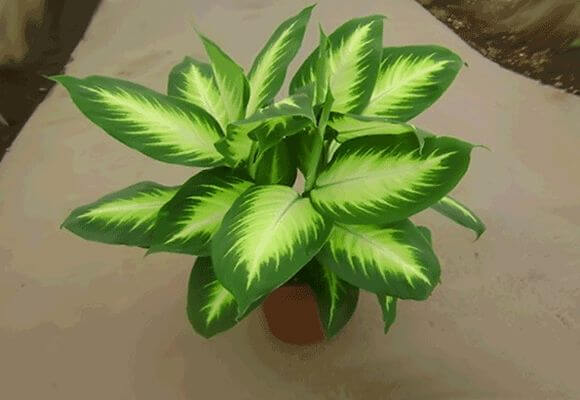

Dieffenbachia adorable or pleasant (Dieffenbachia amoena)
The most unpretentious plant for keeping at home. The owner of an indoor flower only needs to monitor the moderate moisture of the soil. Compared to other types of Dieffenbachia, this culture tolerates drought conditions, so its decorative appearance does not suffer in the winter season, even when the heating is on. The adorable Dieffenbachia grows up to 1.5 meters in height and has wide leaves on which veins with white stripes are located.
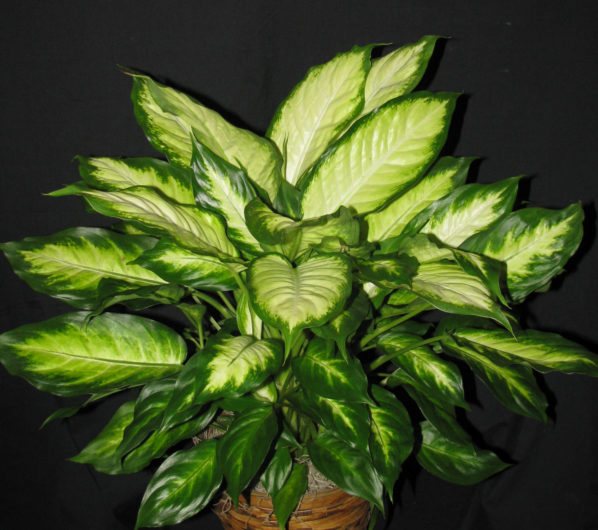

Dieffenbachia seguina
The appearance of the Seguin Dieffenbachia is similar to the spotted plant variety. But unlike the latter, Seguin has a wider leaf surface.There are few veins on it, reaching up to 9–12 cm in length. The leaf blade is located on short petioles.
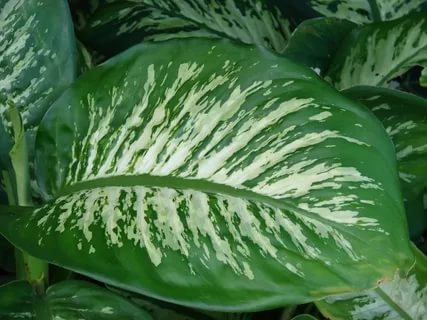

Dieffenbachia oerstedii
The poisonous shrub of Oersteda has large leafy plates of rich green color. The leaves have pointed ends with a pronounced central vein, the length of which reaches 35 cm.
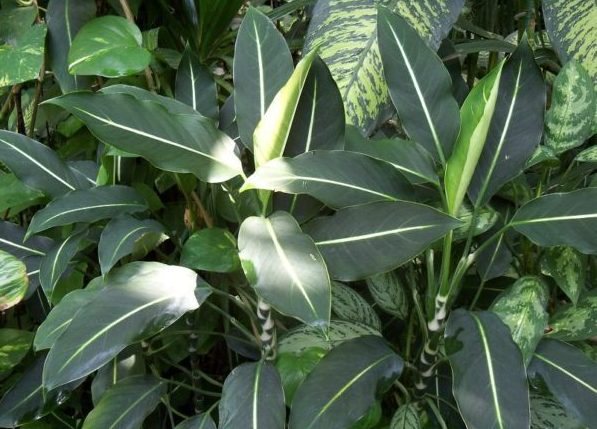

Dieffenbachia magnifica
Variegated Dieffenbachia is characterized by the presence of many white dots located over the entire surface of the leaves and their petioles. Thanks to this feature, this type of dieffenbachia was called royal or magnificent.
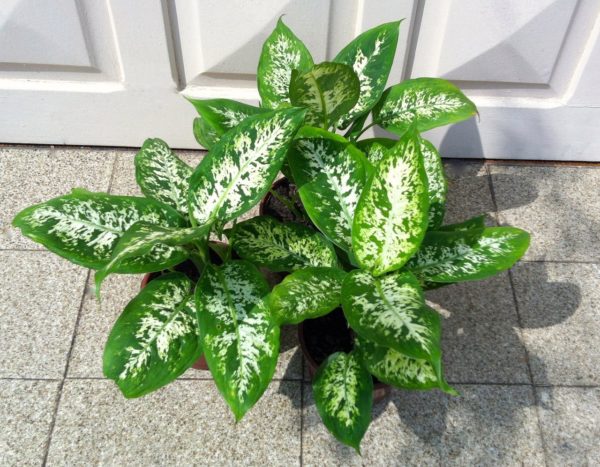

Dieffenbachia macrophylla
Despite the telling name, this type of dieffenbachia does not have the largest leaves. At the same time, the leaf plates are distinguished by an ovoid shape and are colored uniformly, in green. It is not a variegated plant with white veins.
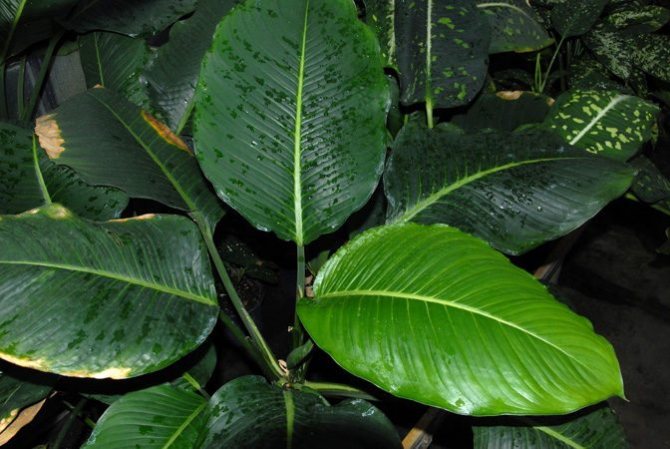

Dieffenbachia bowmannii
Dieffenbachia Baumann has the largest leaves, the length of which ranges from 70 to 80 cm. Painted in dark green. Light spots are located on their surface. Dieffenbachia Baumann ranks first among the plants with wide leaf blades that are grown at home.


Dieffenbachia bausei
Bauze is appreciated by flower growers for its aesthetic appearance. Compared to other dieffenbachia, the shrub has small leaves, the length of which is 40 cm.Their surface is painted in a green tint with a yellowish tint. The leaf blade in the middle is decorated with many white and dark spots.
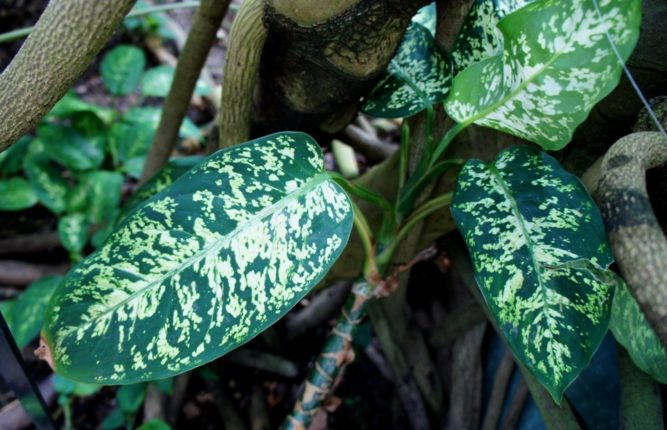

What is needed for the procedure to be as effective as possible
First, the plant is best propagated in spring or early summer. This is a period of active growth of dieffenbachia. That is, the cuttings will themselves "help" you.
Secondly, if the stalk is small or you germinate it late (in the fall), it is better to root it under a greenhouse from a bag or an inverted jar.
Finally, always use the sharpest knife possible. If your instrument is dull, it will crush the stem of the plant. Such a stem will germinate much worse.
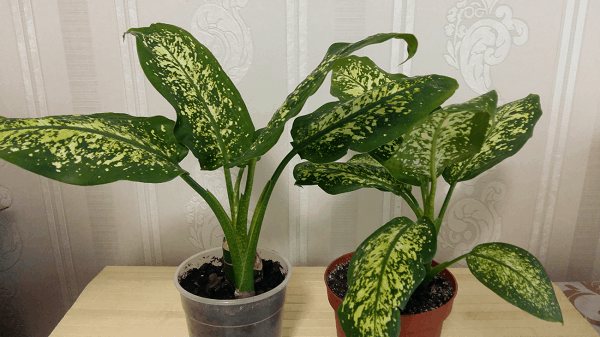

Plant care after transplant
- Soil for a rooted flowerpot: light, nutritious, slightly acidic. A good example: deciduous soil + sand + peat + some vermiculite.
- Choose a large pot. First, Dieffenbachia will grow rapidly. Secondly, the pot must be heavy so that the tall plant does not outweigh it. But at the same time it should not be quite a "bucket", otherwise dieffenbachia will grow only at the root.
- Drainage is a must when planting, even if dieffenbachia is still quite tiny. In addition to expanded clay, you can also add stone / coal chips to the drainage.
Propagation by stem cuttings
You can also get a new ornamental plant by reproduction of it by segments of the stem... This method is used to rejuvenate sufficiently tall plants, which no longer have leaves in the lower part of the trunk. Bare trunks can sometimes break off.
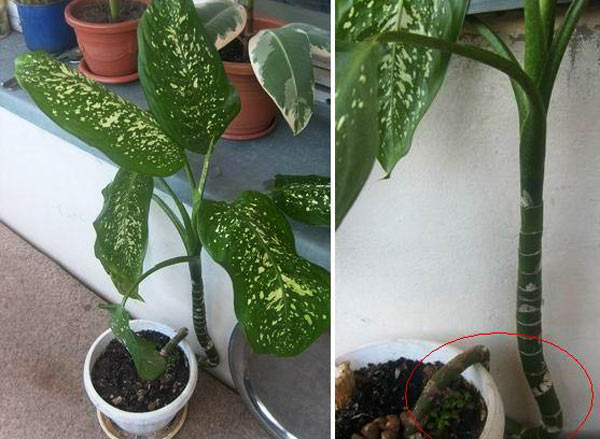

To avoid this, the plant is cut off a dozen centimeters from its base. The trunk is cut into 10-15 cm segments. Dieffenbachia propagation by stem cuttings is carried out in the following ways:
- The stem is buried in the ground to a depth of a couple of centimeters, covered with a plastic bottle. Water and air the plant periodically.
- They put the stem segments on the ground and press them a little, cover them in the same way as in the previous case with a greenhouse. Airing and watering is also required. Young twigs will develop from the buds. Over time, they will turn into a lush bush.
- You can root the stems in water in the same way as with the top shoots. When three-centimeter roots appear, the plant must be transplanted into a spacious flowerpot.
For home use... Cuttings taken from the middle of the shoot take root most quickly. It is more efficient to propagate the top in water, and the root part of the trunk in the soil. A stump left in the ground will also give rise to a new plant, if, after putting the pot in a well-lit place, you do not stop watering it.
Pest and disease control
Dieffenbachia belongs to those plants that clearly and visually signal the owner about the problems that have arisen.
Most often this is expressed in:
- drying out of deciduous ends, which may indicate insufficient air humidity, increased acidity of the soil or the presence of drafts;
- rapidity in the fall of the lower layer of leaves, caused by a lack of moisture in the soil or tightness of the pot;
- pallor of green color, provoked by excessively bright lighting or excessive phosphorus content in the soil;
- deformation and crushing of leaves, which indicates an excessive content of alkali in the ground;
- root rot caused by excessive watering;
- thinning of the stem, indicating the old age of the bush.
Fungicidal preparations (for example, "Fitosporin-M") will help to get rid of many serious problems.
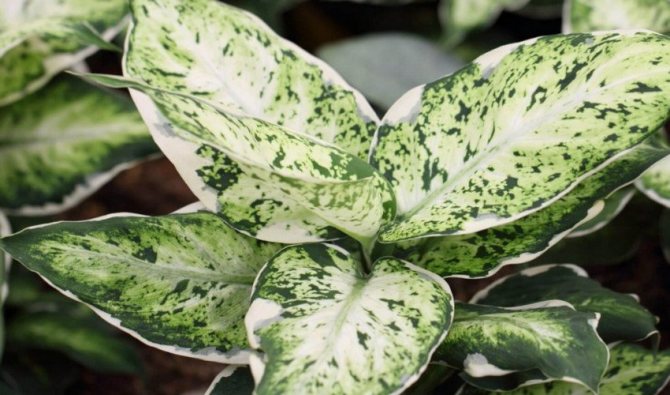

In addition to violations of agricultural practices, the plant can suffer from an invasion of pests in the form of:
- mealybug, which forms flakes in the form of flour on the bush and soil, and which is most effectively dealt with with the help of "Mospilan" or "Aktara" preparations;
- thrips, due to which dark drying spots appear on the leaves, and which are fought with insecticides by repeatedly spraying the bush every 2 days (covering the plant with a plastic bag helps);
- a spider mite, giving away its presence with drying leaves and a poorly distinguishable cobweb on their back (the mite is destroyed with insecticides by spraying and covering the bush with a transparent bag for several days, repeating the procedure every week);
- aphids, provoking yellowing of leaves (they fight with garlic infusion, a solution of laundry soap and even beer).
Important! Permanently low ambient temperatures can lead to the formation of brown spots on the leaves.
Dieffenbachia leaf breeding method
Reproduction of dieffenbachia by a leaf does not give one hundred percent result, because new shoots sometimes die for various reasons. For reproduction, it is better to choose the bottom leaf, which is closer to the roots. The leaf should be healthy, green and firm. With a sharp, disinfected knife, it must be cut into several parts. After that, parts of the sheet need to be dried in the fresh air for several hours. Then they can be rooted either in water or directly in the ground. To make rooting faster, you can treat parts of the leaf with a growth stimulant. After planting the leaf in a nutritious and lightweight substrate, the container must be closed with a plastic bag to maintain a high level of humidity and create greenhouse conditions. When the roots appear on the leaf 2-3 centimeters long, it must be transplanted to a permanent place in the nutrient soil.
Selection of cuttings
To get new Dieffenbachia from an old plant, you can use:
- apical stalk. This is the top-most leafy part of the trunk. It is cut off at the top of the flower. Such cuttings are usually quite large - from 20 to 40 centimeters in length;
- stem cuttings. They are obtained by cutting a bare trunk into several pieces 5-10 centimeters long;
- lateral processes. Sometimes dormant buds wake up on the bare stem of Dieffenbachia and begin to grow in the form of lateral shoots. If so, they can be carefully trimmed and rooted in soil or water.
How to propagate dieffenbachia by cuttings and leaves
Dieffenbachia is a popular evergreen perennial that naturally grows in the tropical climate of America.This flower is a member of the Aroid family and can be grown at home. Many are interested in how dieffenbachia reproduces? This process is quite simple, but it is necessary to adhere to a certain sequence of actions and know some rules, thanks to which reproduction will be successful.
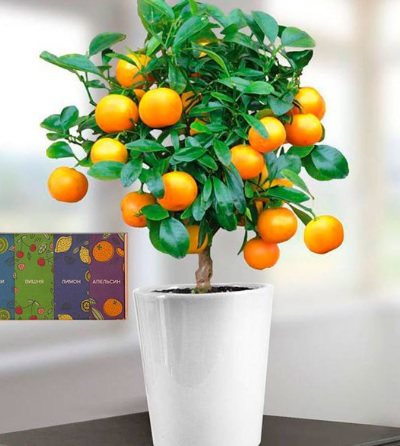

Dieffenbachia: benefits and harms
Dieffenbachia has the following beneficial properties:
- absorbs and neutralizes volatile toxic compounds, improving air quality;
- moisturizes the room;
- protects against insects;
- removes fine dust particles;
- due to the high content of phytoncides, it relieves the room of pathogenic microorganisms, prevents the growth of a large colony of staphylococci.
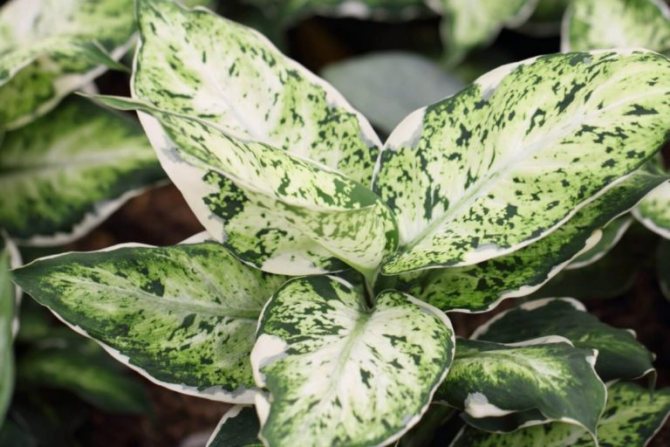

Is dieffenbachia poisonous
Dieffenbachia is a poisonous plant. Dieffenbachia juice is poisonous. When fiffenbachia juice gets on the skin and mucous membranes, it provokes edema. This is a strong allergen that can lead to skin irritation, itching, and rashes. When ingested, it causes intoxication. The juice is dangerous only if the integrity of the plant integument is violated.
In an adult, toxins are quickly detoxified in liver cells, but while they are in the blood, he may feel nausea, dizziness, and muscle weakness. The child's body cannot cope with such a load, so it may require medical attention. A similar situation is observed when keeping pets. Small pets may die.
Gloves should be worn when caring for dieffenbachia to avoid contact with plant sap.
Can Dieffenbachia be kept at home?
This decision should be made by the plant owner individually. Plant maintenance is not recommended if there are:
- people with individual intolerance to the components that make up the chemical composition of vegetable juice;
- children under 3-4 years old;
- pets, especially cats.
In other cases, dieffenbachia does not pose a threat to human life. In this case, precautions must be taken to avoid unpleasant consequences in the form of dermatitis or burns.
People who are prone to allergic reactions may develop anaphylactic shock.
Dieffenbachia should not be grown in preschools, health centers, and sleeping quarters. The latter is due to the fact that an evergreen plant begins to produce carbon dioxide at night. This can cause people to experience poor sleep quality. They will begin to feel tired, their performance will decrease.
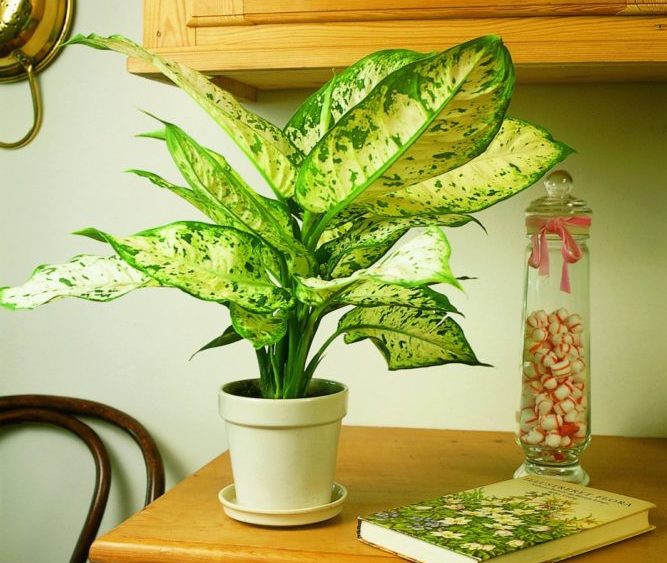

Safety precautions and assistance for dieffenbachia juice poisoning
During pruning or transplanting, children and animals should not be allowed to approach dieffenbachia. It is necessary to work with shrubs in protective gloves, to protect eyes from getting juice. It is recommended to wear clothing that covers as much of the skin surface as possible.
If the juice gets on the mucous membranes, skin and eyes, you must immediately rinse it off with running water. It is strictly forbidden to swallow the juice from the leaves of the plant. If symptoms of intoxication appear, you need to call an ambulance. As part of first aid, you should:
- give the victim warm water, milk, a weak solution of potassium permanganate;
- monitor the ingestion of an adsorbent (activated carbon), which prevents the absorption of toxins in the small intestine;
- inform the doctors about the time of swallowing the juice, the symptoms that have appeared.
To reduce the danger to children and animals, it is necessary to place dieffenbachia in a place that is hard to reach.
When to propagate Dieffenbachia?
Cutting and rooting of young plants is best done in the spring, when the active growing season begins. However, Dieffenbachia is completely non-capricious and takes root quite well at any other time of the year, especially with the use of root formation stimulants.
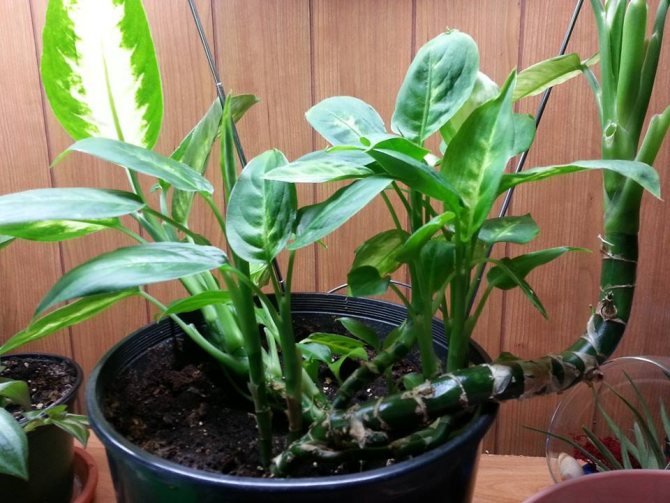

The twisted and bare dieffenbachia trunk (right) needs rejuvenation through cuttings
Reproduction and transplant problems - table
| Problem | The reasons | Elimination |
| Cuttings do not have roots in water for a long time. | Low rooting temperature, the mother plant lacked feeding. | Raise the temperature to 22-25 degrees. Add rooting agent (Kornevin, Heteroauxin), stimulant (Zircon, Epin) and ground charcoal to the water. 5 drops of a stimulant, a rooting agent on the tip of a knife, half a teaspoon of charcoal. |
| The tips of the cuttings began to turn black in the water. | Decay. | Cut off the blackened ends, dry for a couple of hours. Add Methylene Blue + Root + Fitosporin to the water. Change the water 1-2 times a week. |
| The rooted top began to shed its leaves. | Cold; drafts; poor soil condition; too little light; drought. | The temperature of the content in the summer should be at least 20 degrees. In winter, at least 18. Do not flood the flower, do not dry it, and spray the leaves with warm water. You can add 1 tablet of succinic acid to the water for stimulation (dissolve in hot water). Spray every morning, with succinic acid - once a week (the solution is stored for 3 days in the dark). Provide good lighting, but not direct sunlight. |
| New leaves dry out at the tips and edges. | Lack of moisture, dry air. | Spray the leaves, you can arrange a warm shower. Do not overdry the soil. Place sphagnum moss on top of the soil. |
| The trunk of the planted Dieffenbachia began to fade. | Filled with soil or the presence of pests. | When flooding, dry the soil until it is completely dry, at this time spray the leaves (you can add Epin). When the ground is dry, pour with the addition of Fitosporin. Carry out the treatment every three times to prevent rot. You can also water the soil with such means as Alirin-B, Fitolavin (it will be useful to alternate these means). Check the soil and leaves for pests. Treat with drugs if found. From gnawing roots: Thunder-2; from leaf: Fitoverm. |
| Cuttings rooted in the substrate do not sprout. | Unfavorable conditions, dry substrate, insufficient air humidity. | Check the conditions: Temperature: 25-27 ° C; wet substrate; shine. Make a greenhouse and place in a warm, well-lit place. The substrate and cuttings can be sprayed with the addition of a stimulant. |
| The cuttings turn yellow. | We haven't changed the water for a long time. | Change the water by adding crushed charcoal. Rinse the cuttings with warm water. |
Reproduction of this decorative leaf step by step
There are many reasons for breeding a flowerpot:
- he may need an update, since the old dieffenbachia over time will not only rest against the ceiling and begin to grow parallel to it, but will also begin to resemble a bare stick crowned with a bunch of leaves;
- your flowerpot may break;
- from one dieffenbachia you will need to make several for friends or for sale.
Below I will talk about the most popular household breeding methods for dieffenbachia. I will not talk about the seed method.
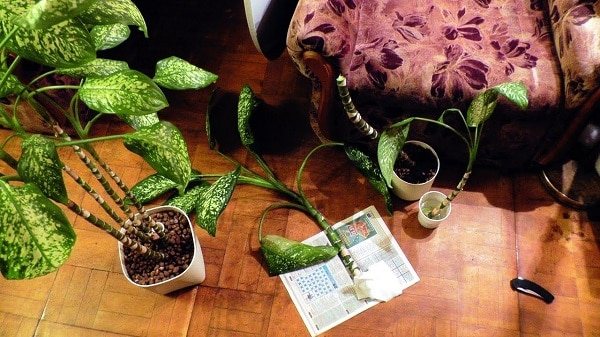

Firstly, we practically cannot get seeds, and secondly, this method is too long and unreliable. Only breeders who grow new varieties turn to it.
Rare types of bush dieffenbachia can also be propagated by dividing the bush. This is done when transplanting.
Remember! Dieffenbachia is known for its poisonous juice. Therefore, all manipulations with it are best done with gloves!
Apical cuttings
This is the easiest way - as well as the fastest, because the point of growth of such plants is located exactly at the top. Having rooted in this way, Dieffenbachia will grow a leaf every week, very quickly turning from a cutting into an adult plant.
- Cut off the top so that the stalk is 10 to 15 cm in size. You do not need to cut it longer - even if a large stalk releases the roots, it will be difficult for them to "feed" such a plant by extracting nutrients in the soil.
- Milky juice will begin to stand out from the slice. It needs to be removed. Some people wash the cuttings under the tap, others rinse the cut in a glass of water (changing the water as needed), and still others simply wipe it off with a few paper napkins. All options are correct.
- You can root the stalk as in a glass with clean (or mixed with an energy drink - succinic acid, "Epin") water, a wet mixture of peat and sand, moss. It is not necessary to deepen the cutting very much - 2-3 centimeters will be enough. Before rooting, the slice can be dipped in "Kornevin" - this tool accelerates the emergence of roots.
- Keep the cutting in a warm place (22-24 degrees), keep out of direct sunlight, spray often.
- If the cutting is in the water, you will not miss the emergence of roots. Let them grow up to 3 cm and you can plant the plant in your own pot.
- Do you grow dieffenbachia in soil? The signal for the emergence of roots will be new leaves that will grow on top of the plant. If you saw such leaves, you can transplant the cutting into the ground more seriously.
By the way! After cutting off the top, do not discard the stump if it (and the roots) are healthy. Leave it at least 10 cm long.
Blot the stump from the emerging juice, and then seal it with wax from the burning candle (it will protect it from rot - however, this is not a prerequisite). Water the plant, and after a while new tops (one or even several) may sprout on the sides of the "seal".
Dieffenbachia can be left as is. But if it seems to you that the "stump" plant looks untidy, you can cut off all the grown tops and root.
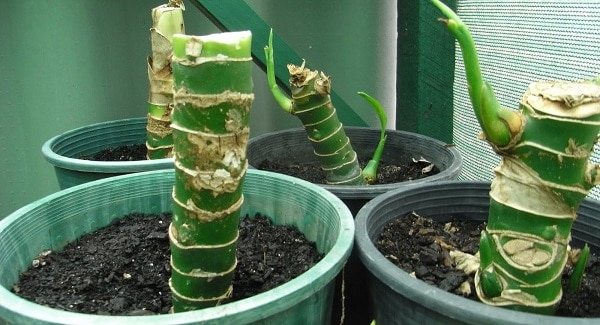

Stem cuttings
The bare trunk of Dieffenbachia will also be used.
It can be dried (washed) from the juice and used in two ways.
- Cut the trunk into cuttings about 10 cm. The main thing is that each has at least one internode. Dip them into Kornevin from the bottom (optional), seal them with wax from the top. Stick the lower part into water, wet moss, sand, sand + peat. Root them as described above.
- Lay the cuttings sideways in the ground (as in the photo above). If you see kidneys, make sure they are on top. Cover the pot with plastic wrap (transparent bag) and keep warm. In this case, you need about 25 degrees. The sprouts that have appeared on the cuttings will tell about the rooting of these processes. They can sprout in a row on this cutting.
Is it possible to keep a Dieffenbachia flower at home?
Dieffenbachia is a beautiful and spectacular indoor flower, but it will not be harmless to everyone. So why can't you keep Dieffenbachia at home?
Dieffenbachia lovers should know that its juice is poisonous, it causes irritation, burning, swelling, redness if it gets on the skin of a person, and if it gets on the mucous surface of the skin - numbness. Therefore, pets should be restrained if they suddenly decide to feast on the leaves of a plant, and all work on caring for it (transplanting, pruning leaves) should be carried out with gloves.
Leaf propagation
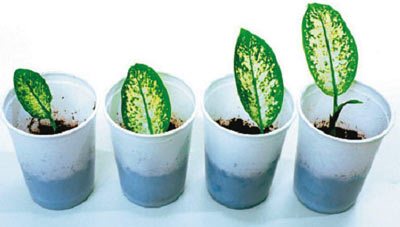

This method in indoor floriculture is used less often than others because of the duration and optional survival of the planting material.
In this case, healthy and undamaged leaves with petioles are preliminarily kept in the Stimulin solution for a couple of hours.
The upper leaves are sent to the water. And the lower specimens are placed in an earthen mixture. The use of mini-greenhouses, maintaining comfortable temperature conditions and sufficient soil moisture is mandatory.
Transplanting and dividing a bush: how to plant cuttings correctly
Dieffenbachia roots grow well and eventually fill the entire pot. If dieffenbachia has given several shoots from the root, they can be separated from the mother plant and planted separately.
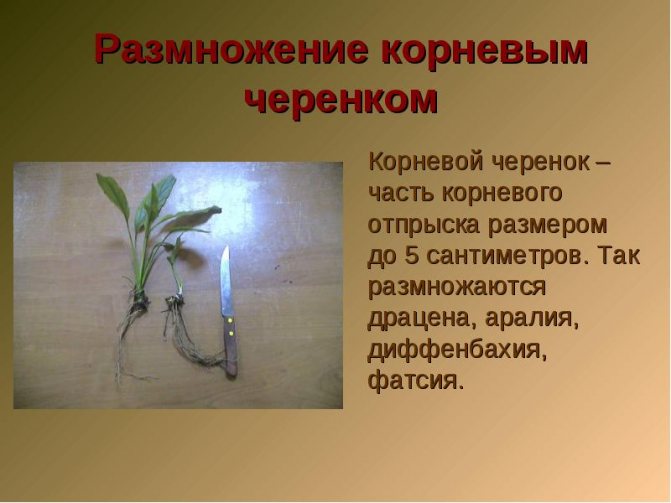

You can easily separate the sprout from the mother bush and plant it separately
You need to get the plant and check if the daughter bushes can be separated. This is usually easy to do and the roots are barely damaged.If you cannot separate it with your hands, you can cut it off with a sharp disinfected knife. Try to do as little damage to the roots as possible!
This bush can be divided into two
The trunk of spotted dieffenbachia grows quickly and can tilt the plant. In this regard, it is better to plant it in a heavy pot slightly larger than the size of the roots, so that there is where to pour the soil. Excess roots can be trimmed.
When planting to the top of the pot, there should be a free space of 1.5-2 cm.
When a transplant is required:
- growth has stopped;
- new leaves grow small;
- the soil dries very quickly;
- the plant has grown too much and needs renewal.
Prepare for transplant:
- new soil;
- disinfected scissors;
- antiseptic (coal powder, turmeric or brilliant green);
- drainage to the bottom of the pot.
Dividing the dieffenbachia bush - video
Transplant instruction and division of the bush
- Place drainage on the bottom of the pot.
- Remove the plant from the pot.
- Examine the roots and soil.
- Separate the daughter shoots from the main bush.
- If necessary, free the roots of the mother plant from old soil and remove any dark, dry and rotten roots. If the soil and roots are not diseased, then it is better not to release the soil from the roots.
- Treat all sections with an antiseptic.
- Try on the roots in a pot and add soil. Holding the dieffenbachia by the trunk, fill up the earth, tamping it down a little. The trunk can be buried.
- Sprinkle a mixture of sand and charcoal on top and lay sphagnum on top of the mixture.
- Water the plant lightly and spray the leaves with warm water.
- Plant the separated Dieffenbachia shoots in the same way.
The first month you need to keep the plants in a shaded place, especially if you cut the roots. Next, place the dieffenbachia in a brighter place.
Dieffenbachia transplant - video
Apical cuttings rejuvenation
This method is most often used to rejuvenate dieffenbachia. If the lower part of the trunk is bare and twisted with age, but the top of the plant still has a beautiful decorative appearance, it can be cut off and re-rooted.
To avoid plant contamination, treat your knife or pruner with alcohol before pruning. The top of the tree must be cut so that the node from which the foliage grows is 2 centimeters above the cut.
How to root properly
The easiest way to root top cuttings is in water. To do this, the cuttings should be placed in a jar of clean water and wait for the roots to appear. To prevent decay of the trunk, dissolve one or two tablets of activated carbon in water and change the water at least once a week. The first roots will hatch in about one to two weeks. If you decide to rejuvenate the plant in winter, the plant will take longer to form a root system.
After the roots appear, wait until they grow up to two to three centimeters in length, and transplant the dieffenbachia into a pot.
Many growers do not want to contemplate the cuttings in jars on their windowsills and use the method of rooting with the help of soil. If you immediately bury the cut part of the plant in the soil, you can immediately get a ready-made decorative flower in a pot. But this, of course, will only be visual, the cuttings will take some time to take root anyway.
For rooting, it is recommended to place future dieffenbachia in small pots with loose and breathable soil. When keeping cuttings in a large pot, it is rather difficult to monitor the condition of the earth; it can remain wet for a long time and not dry out, which will ultimately lead to rotting of the trunk.
Recommendations for the care of a young plant
A flower that has not yet matured is placed on the western and eastern windows, providing it with diffused lighting and avoiding the burning sunlight on the leaves. The ambient temperature must be within + 25 ... + 27 ° C.Watering the soil should be done carefully and only after the top layer of the substrate dries out, since the roots cannot yet absorb moisture in large quantities. Once a day, spraying with soft, settled water from a spray bottle is carried out.
We recommend reading a detailed article on plant care.

